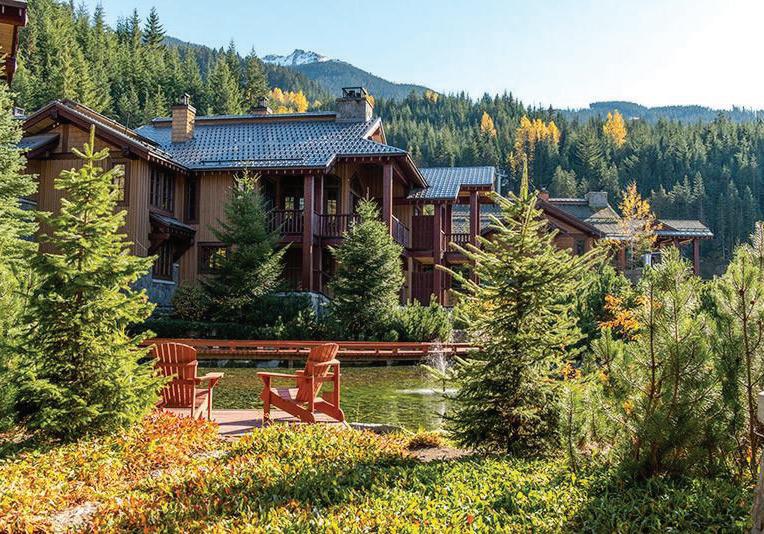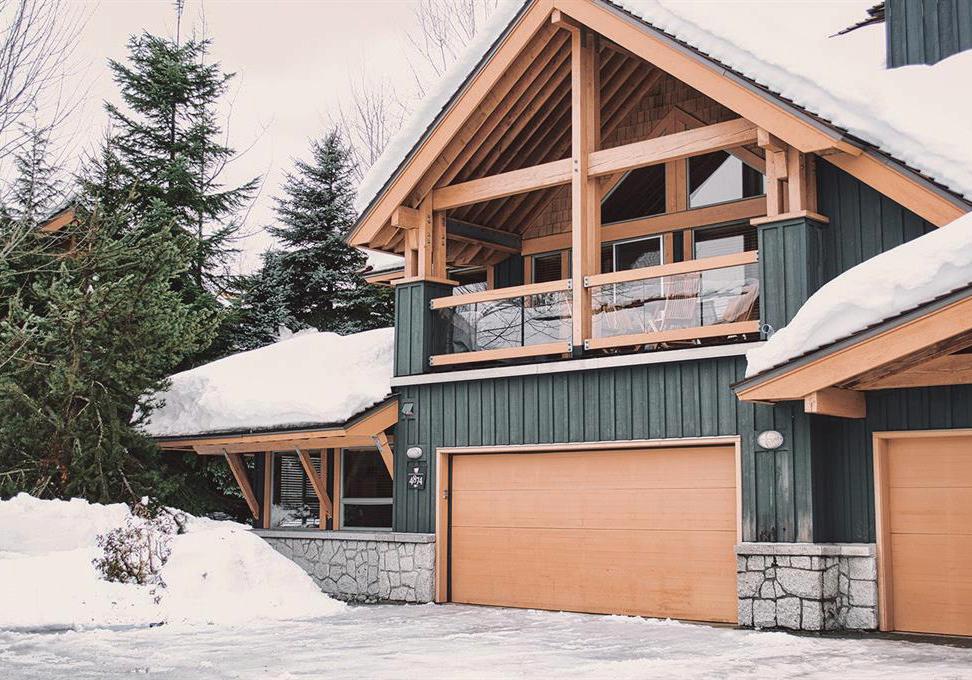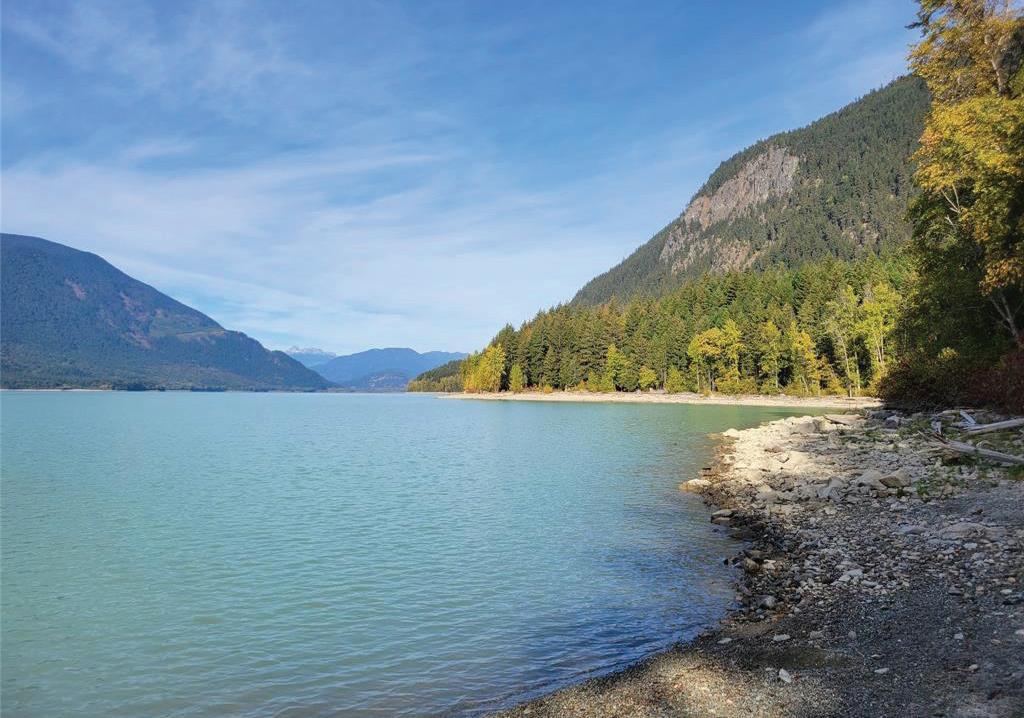








































































































British Columbia’s coverage of contraceptives should inspire the rest of North America. - By Candace
 Johnson / The
Johnson / The
Conversation
14 SPRING OOPS
Whistler Blackcomb is apologizing after a rocky start to spring operations left guests and locals fuming.
As Pemberton’s OCP review continues, locals are largely concerned about familiar issues like growth management, affordable housing and climate change.
15 VALLEY VISIONARY Remembering Garry Watson, the lawyer, councillor, developer, and Whistler visionary who never stopped giving back.
17 ENGAGE
Whistler’s mayor and council moved to limit the amount of feedback allowed at public meetings on April 18.
36
TIME Multi-sport Whistler prodigy Marcus Goguen reflects on a breakout freeride ski season.

40
John McLachlan and Marc Atkinson’s show, Early Morning Rain, is a “love letter” to the music of Gordon Lightfoot.
COVER While decisions like these are certainly a step in the right direction, they always make me wonder why it’s still cost prohibitive to live with chronic diseases like diabetes, asthma or any other illness that requires taking medicine every single day just to stay alive. - By Jon Parris // @jon.parris.art




















































Founding Publishers KATHY & BOB BARNETT
Publisher SARAH STROTHER - sstrother@wplpmedia.com
Editor BRADEN DUPUIS - bdupuis@piquenewsmagazine.com
Sales Manager SUSAN HUTCHINSON - shutchinson@wplpmedia.com
Production Manager AMIR SHAHRESTANI - ashahrestani@wplpmedia.com
Art Director JON PARRIS - jparris@wplpmedia.com

Advertising Representatives
TESSA SWEENEY - tsweeney@wplpmedia.com
GEORGIA BUTLER - gbutler@wplpmedia.com
Digital/Sales Coordinator SHANNON CALDWELL - scaldwell@wplpmedia.com
Production production@piquenewsmagazine.com
Features Editor BRANDON BARRETT - bbarrett@piquenewsmagazine.com
Arts Editor ALYSSA NOEL - arts@piquenewsmagazine.com
Social Media Editor MEGAN LALONDE - mlalonde@piquenewsmagazine.com
Reporters
BRANDON BARRETT - bbarrett@piquenewsmagazine.com
MEGAN LALONDE - mlalonde@piquenewsmagazine.com
ALYSSA NOEL arts@piquenewsmagazine.com
ROBERT WISLA - rwisla@piquenewsmagazine.com
DAVID SONG - sports@piquenewsmagazine.com
Classifieds and Reception mail@piquenewsmagazine.com
Office and Accounts Manager HEIDI RODE - hrode@wplpmedia.com
Contributors G.D. MAXWELL, GLENDA BARTOSH, LESLIE ANTHONY, ANDREW MITCHELL, ALISON TAYLOR, VINCE SHULEY
President, Whistler Publishing LP
SARAH STROTHER - sstrother@wplpmedia.com
10
13 #202 -1390 ALPHA LAKE RD., FUNCTION JUNCTION, WHISTLER, B.C. V8E 0H9. PH: (604) 938-0202 FAX: (604) 938-0201 www.piquenewsmagazine.com Pique Newsmagazine (a publication of Whistler Publishing Limited Partnership, a division of Glacier Media) distributed to over 130 locations in Whistler and to over 200 locations from Vancouver to D’Arcy. The entire contents of Pique Newsmagazine are copyright 2023 by Pique Newsmagazine (a publication of WPLP, a division of Glacier Media). No portion may be reproduced in whole or in part by any means, including electronic retrieval systems, without the express written permission of the Publisher. In no event shall unsolicited material subject this publication to any claim or fees. Copyright in letters and other (unsolicited) materials submitted and accepted for publication remains with the author but the publisher and its licensees may freely reproduce them in print, electronic or other forms. Letters to the Editor must contain the author’s name, address and daytime telephone number. Maximum length is 250 words. We reserve the right to edit, condense or reject any contribution. Letters reflect the opinion of the writer and not that of Pique Newsmagazine Pique Newsmagazine is a member of the National Newsmedia Council, which is an independent organization established to deal with acceptable

ISSN #1206-2022
Subscriptions: $76.70/yr. within Canada, $136.60/yr. courier within Canada. $605.80/ yr. courier to USA. GST included. GST Reg. #R139517908. Canadian Publications Mail Product Sales Agreement #40016549.
PIQUE’N YER INTEREST Columnist Alyssa Noel is coming to terms with the fact that she may be drawn exclusively to cute and semi-unique old-lady names for babies.
62 MAXED OUT Vail Resorts claims that safety is its No. 1 priority—but Max isn’t buying it.
LETTERS TO THE EDITOR This week’s letter writers make an appeal for local artists, and weigh in on recent operations issues at Whistler Blackcomb. 32 RANGE ROVER Leslie Anthony shares some thoughts on trails, including who uses them and why, and what we should keep in mind when building them. 38 EPICURIOUS Jordanian chef Adie Anas brings a little bit of the Middle East and a lot of B.C. to his new menu at the Wildflower.
6 APRIL 21, 2023 Open Daily 10am - 6pm OR www.thebeachwhistler.com S w i m . A c t i v e . L i f e s t y l e - Vo t e d W h i s t l e r ' s F a v o u r i t e C l o t h i n g S t o r e















I USED TO SCOFF when my mother would talk about the power of words; of invisible, universal vibrations and vast forces beyond our control or understanding.
I fashioned myself an unflappable, no-nonsense realist, for a time at least, and no amount of pseudo-self-help bullshit was going to break down my barriers.
 BY BRADEN DUPUIS
BY BRADEN DUPUIS

So when mom sent me for my birthday one year a box full of literal rocks, much scoffing and eye-rolling ensued.
Thanks for the rocks, mom.
But they weren’t just any rocks—each one came with a simple inscription: words like love, courage, joy, gratitude, and peace.
I set them aside, not thinking much of it other than I would have preferred some cash, or something more practical.

But over time I have come to understand the true power words can have on our day-today lives—and in turn, the wider world and the way we interact with it.
With Earth Day set for Saturday, April 22, it’s worth thinking about how this relationship plays out in our discussions about climate change. Are phrases like “heat dome” and “climate time bomb” and “irreversible consequences” helpful? Or are they just pushing more anxiety on an already-too-anxious populace?

In a recent episode of CBC’s Planet Wonder, climatologist Johanna Wagstaffe posed the question: Is talking about climate
change actually making it worse?
The short answer is, yes—and not just anecdotally. A recent Gallup World Risk poll found global concern over climate change actually fell 1.5 per cent last year.
“How we talk about climate change matters. The way we talk about climate change right now is unfortunately not great for engaging people in this topic, because the current narrative on climate change is about doom and gloom,” behavioural psychologist Jiaying Zhao told CBC.
“The framing right now is very negative, and this negativity makes us feel anxious, depressed, withdrawn, so we’re actually not

of what we hope people would do. And this is where we need to turn the narrative into a positive frame.”
One way to do that is by shifting the focus from personal sacrifice, which comes with inherent negative connotations and makes people feel shameful or guilty, to something more positive.
“Instead of saying ‘drive less,’ we should say, ‘drive more people.’ Why is that important? One, you are driving more people who would otherwise be driving by themselves, so you are saving the emissions by carpooling. Second, social connections, hanging out with friends and family in the car, actually can make you
she said.
“That’s kind of the principle of happiness, is abundance reduces appreciation. Instead, we should make those, let’s say high-emission items, foods, or activities, a treat.”
The power of words goes well beyond how we frame discussions in the public square. The words we centre in our minds each day are active determinants in our underlying state of being, whether we realize it or not—which is what my mother was trying to explain to me by sending me inscribed rocks for my birthday.
And while I used to scoff, I have come to rely greatly on my rocks in recent years, rotating the words I need on a given day to
effectively engaging with the topic.”
Zhao’s proposed alternative is called the “happy climate” approach—reframing the conversation around things we can do to reduce emissions that will also make us happy.
“I think the doom-and-gloom narrative is too heavy,” Zhao said. “It’s paralyzing. It makes us retreat and disengage. So the behavioural impact is actually the opposite


feel happier, because social interaction is the No. 1 predictor of happiness around the world,” Zhao said.

“It’s not to say don’t drive, or drive less. No, drive as much as you want, but drive other people with you.”
Or, rather than saying “eat less meat,” we can pledge to “eat more plants,” Zhao added.

“Yeah, eat meat, but make it a treat,”
the front of the pack; pushing those I’d rather forget, for now, to the back.
It’s not magic, or a cure-all. We cannot will good things into existence, or alter the fabric of reality with our words.
But we can, each and every one of us, be a force for positivity in the world, however we show up in it each day.
So choose your words carefully. ■
“I think the doom-and-gloom narrative is too heavy. It’s paralyzing. It makes us retreat and disengage. So the behavioural impact is actually the opposite of what we hope people would do. And this is where we need to turn the narrative into a positive frame.”
- JIAYING ZHAO

3 B E D R O O M TOW N H O M E S I N S Q UA M I S H
P R I C E D F R O M $ 1 ,0 6 8 ,0 0 0

N e s t l e d b e t w e e n W h i s t l e r a n d Va n c o u v e r i n b e a u t i f u l S q u a m i s h , t h i s
s t r i k i n g c o l l e c t i o n o f t h r e e b e d r o o m t o w n h o m e s i s d e s i g n e d f o r t h o s e
w h o l o v e s p e n d i n g t i m e i n n a t u r e P l u s , m o s t h o m e s h a v e t h e c o n v e n i e n c e o f a s i d e - b y - s i d e d o u b l e c a r g a r a g e f o r s t o r i n g a l l y o u r a d v e n t u r e g e a r

O P E N 12 - 6 P M DA I LY
( e x c e p t F r i d a y s )
2 0 6 0 D o w a d D r i v e , S q u a m i s h h i g h l i n e @ p o l y h o m e s c o m
6 0 4 7 5 7 5 5 5 0 p o l y h o m e s c o m







Can you remember your first season in Whistler? The first time you visited this place? The first time you went out for a night at The Boot? Maybe you saw The Hairfarmers at Merlin’s, or a Marble Canyon show at the GLC, or Monty Biggins and Kostas performing at the Whistler Ski and Snowboard Festival!


Whistler and its vibrant music community used to be synonymous with one another. People would come for all the incredible outdoor activities and stay for the creative and inspiring arts scene—a scene that would punch far above its weight for the size of our community.

Working in the arts and culture sector and being the frontman of a local band (The Big Love Band), I have seen first-hand the state of our live music scene here in Whistler and its recent decline. I personally went from performing one to two nights a week with a full band and another one to two nights solo, to this winter where I’m lucky to have two solo shows in a month. Musicians from across the Sea to Sky used to flock to Whistler for a chance to play one of the many lively venues only to now have Whistler locals commuting to Squamish and even the city (making enough to cover gas) for the chance to find a stage.
The decline in our local music scene should be something this community takes personally.



We need to foster our music community.

There needs to be investment in performance space, or incentives for existing spaces to provide a home to our local live musicians. Performers need rooms to practice their craft. Original work should be celebrated. To sum these ideas up, arts and culture needs to be funded! Some folks reading this might incorrectly interpret this as the art sector looking for handouts, but I would say that the revenue generated by a healthy music scene is proven. Cities around the world have recognized the benefits of supporting a thriving
music ecology and industry. Vancouver was recently one such city that had seen a need and stepped up with its 10-year “Culture Shift” plan, which includes a “Vancouver Music Strategy” to put more supports in place to revitalize its industry. Now, I understand we are not a city, and Vancouver has a host of different challenges, but our tourism industry can stand alongside some pretty big players. The impact our music community could have on that industry alone seems like reason enough to start investing more into our live
music sector.




Having been a tourist and knowing tourists (yes, they are just people who generally like similar things to you and me, haha) I can say that when visiting a new place it is important to me to have genuine interactions with that place and the people who live there. Can we honestly say, once visitors finish their daytime activities and evening meals (which we do really well), that our nightlife is a genuine expression of our village and our culture? I would argue that we have so much more to give and showcase.
I write this with an intention. That intention is not to join a chorus of negativity or to complain about how things “used to be,” but rather to try and inspire readers to embrace our creatives to make sure we can continue to work in the Sea to Sky!
What can we do to support our artists?




Well, we can book live music in our many venues, to start. When possible, consider the local talent we have right here in the Sea to Sky first. We can tell our elected officials that we want to see support for the arts and culture sector from our municipal government. It’s a fragile sector, but it is vital to the visitor experience (tourism), the community and its well-being.
We can add recorded material to our playlists both for individuals and businesses in town. The royalties earned through plays are not huge, but they do add up. It’s also important to have our songs heard here in town. Who knows? You might just find your new







favourite tune! (On this note, you can find an all-Sea-to-Sky playlist under “This is Whistler” on Spotify.)
We can support organizations that continually work for arts and culture any way we can. That could be by considering donating to help fund programs or by volunteering your time to these organizations.

Most importantly, please try to make it to the shows. Have a look what’s happening in town and make the decision to go and support. It is vital to the success of venues to house these musicians, and guess what? It’s also way more fun than Netflix!
Please don’t stop supporting your artist friends. It’s a tough job, but without them, Whistler would feel a lot… quieter.
Van MeerbergenThis letter was sent to Vail Resorts, and shared with Pique.

It was a friend’s birthday yesterday (Monday, April 17). He drove up from the city to ski on his birthday, as he does every year. When we arrived on Blackcomb we were shocked to see the lineup for the Excalibur Gondola at both mid-station and in the village, and wondered why the Blackcomb Gondola was not running. We decided to have a coffee and take it up a bit later. The lineup only got longer.
Whistler

Much to his disappointment, my friend decided to save the $169 it would have cost him to have three or four runs and return to Vancouver, however, there was no way to get back to the car in the upper parking lot without lining up in that giant lineup. Thankfully, a
AS OF TUESDAY, APRIL 18 April powder? We’ll take it! The weekend’s weather forecast calls for snow, strong wind, and cloudy skies. The freezing level will likely be between 1,500 to 2,000 metres, which means that alpine elevations should receive snow, while lower elevations may see a mix of rain and snow.
With the stormy weather, backcountry users should expect elevated danger ratings. Wind slabs and storm slabs are likely to develop, especially on steep alpine slopes.
To stay safe during stormy weather, it’s best to avoid high consequence terrain. What does high consequence mean? We’re talking about very steep or large slopes that could result in an injury or death. Think steep couloirs, large and open bowls where wide-propagating slabs could be triggered, or slopes with terrain traps



such as cliffs, gullies, and crevasses.
To stay safe during stormy weather, it’s best to stick to low-angle terrain (less than 30 degrees) that doesn’t expose you to overhead slopes.
To stay safe in the backcountry during this stormy weather:
Stick to low-angle terrain (less than 30 degrees) that doesn’t expose you to overhead slopes.
Carefully monitor the bond between the new snow and old surface.




Watch for signs of instability like whumpfing, hollow sounds, shooting cracks or recent avalanches.

Be wary of ridgelines, where cornices could be present and could fail naturally or from your weight.
Enjoy these powder days while we still get them! ■
CONDITIONS MAY VARY AND CAN CHANGE RAPIDLY Check for the most current conditions before heading out into the backcountry. Daily updates for the areas adjacent to Whistler Blackcomb are available at 604-938-7676, or surf to www.whistlerblackcomb.com/mountain-info/ snow-report#backcountry or go to www.avalanche.ca.
St unning 5.5 bed home on the 15th hole of the Nick laus North Golf Course $5,695,000
12 Foxglove
• 3 Bedroom, 2 Bathroom
• Blackcomb Benchlands; close to golf course & ski hill
• Spacious living space with vaulted ceilings


• Two levels, wood fireplace $2,249,000



bed, 2 bath, 973 sqft – Best 1/4 share building in Whistler Horstman House offers owners 1 week each month which you can use personally or have the front desk rent it on your behalf Property is fully equipped has in-house management and is turn key Only a short 5 min walk to Lost Lake, Fairmont Chateau Whistler Golf Course and you can ski home Amenities include; Free shuttle, heated outdoor pool, gym hot tub bbq area ski & bike lockers and secured underground parking
friend who also decided to give up on skiing that day was able to give us a ride.
The guest experience on a scale of one to 10 was -10. What kind of operation are you running? I know you’ve made your money for the season by selling a crap load of Epic Passes. But that doesn’t give you the right to shortchange your customers by shutting down more than half your upload capacity and not running Glacier Chair and not running 7th Heaven until 1 p.m. that day. There was a lot of standing in line and very little skiing.
I was very disappointed for my friend. You managed to ruin his birthday, and I’m probably done skiing for the season. I was looking forward to some good spring skiing on Blackcomb in the coming month, but with only a fraction of the lifts open, it’s not really worth my while. I’ve stood in line long enough this year.
I’m sure your excuse will be that you are unable to hire staff to run all the lifts, but that’s a tired, old ditty we’ve all heard before. If you can’t hire enough staff, you obviously have a problem with your business plan. I don’t know, but I’m just going out on a limb here with the suggestion that you might not be paying enough for people to feasibly afford to live and work in Whistler. This is a problem you need to resolve—yesterday.

With disgust,
Paul vanPeenen // Whistler

Last Monday, April 17, I woke up to new snow on the ground and fairly clear skies. I checked the Whistler Peak site and there was almost 30 centimetres of new snow in the last 24 hours. I was super pumped to have a great pow day. I texted my bud in Revy bragging about the new snow, rubbing it in since Revy just closed.
All good, I parked and started walking to the Excalibur Gondola and very quickly my excitement turned to disappointment. Usually, after Whistler closes, you can walk right onto the Blackcomb lifts, but this was not the case on Monday. At first glimpse, I could see there were a lot of people in line, and as I kept walking I could see the line kept going and going. I decided to see if I could find the end of it, and it was at Lululemon, but going in the opposite direction from the gondola.
At that point, I couldn’t see the end, and gave up and went to The Lift for a latte. Many disappointed people were there, and a friend advised me that the Blackcomb Gondola, along with the Glacier chair, were now closed for the season—even though the season isn’t over. (Editor’s note: Blackcomb Gondola is operating on weekends only; Glacier Express was closed on Monday, April 17, but running the next day).
In more than 55 years of skiing in Whistler, I don’t think I have ever been so disappointed and frustrated about going skiing. It shouldn’t be this way. Skiing is supposed to be fun and worry-free, not frustrating. This lineup was as long as some of the lines in the ’70s and ’80s when the only way up was in the tin can, but back then tickets were a fraction of what they are today. Skiing is supposed to improve with
the new lifts and equipment they have today, not get worse.
I don’t know what a skier or rider who lives in a ski town is supposed to do when you can’t even get up your local mountain in a reasonable amount of time; it makes no sense. Blackcomb has an almost new gondola just sitting there unused that would eliminate this issue. What are we paying for these days?
Since Day 1, many of us skiers living in Whistler and the Lower Mainland have been skiing in Whistler until the end of the May long weekend, nothing new. We are paying customers, too, and deserve and expect to have a better quality of service even once the other Epic ski resort customers are gone. That’s what we paid for. Before Vail Resorts took over, the services and operations were never cut back to this level at this time of year.
Is Vail Resorts engaging in false advertising?


You can’t say you have so many lifts and hundreds of runs if the lifts are not running or runs are not being maintained or groomed. Vail should advise customers that it only operates lifts and maintains and grooms runs and opens restaurants according to how much profit the company wants to take back to its American CEO and shareholders, like a letter writer who advised us in an earlier issue of Pique that skiers and riders need to stop whining and invest in Vail (“Letter: Vail Resorts hate is getting boring,” Pique, Feb. 27). Seems funny that someone living in Whistler would rather see profit from a stock than enjoy the incredible mountains we have. There are thousands of companies to invest in. Vail Resorts would be the last one I would invest in, just for how it treats its customers. Vail Resorts makes our cellphone companies look like angels. Something needs to be done. I don’t know what the answer is. A Skier’s Bill of Rights? A lawsuit, as this is the American way? But Vail Resorts probably has more lawyers on staff than ski people. That letter writer is right about one thing: complaining doesn’t do any good. If my company was being slagged constantly, I would at least have someone from the company address customers’ concerns and try to make improvements. Remaining silent is deafening, and inaction is worse.
I can see why many people have moved out of Whistler to other ski towns owned by independents or Canadian companies. I have considered this too, but I’m too rooted in this town. As mentioned before, I sure hope Vail Resorts and the Alterra Mountain Company, owner of the Ikon Pass, don’t buy all our ski resorts. That will be the end of skiing as we know it.

Ken Mason // Whistler n
“I can see why many people have moved out of Whistler to other ski towns...”
- KEN MASON
THERE ARE SEVERAL THINGS in life that seem more fun and exciting in theory than they wind up being in reality.
Road trips: you get in the car loaded with your fresh, clean pillows, a phone full of podcasts and a great adventure before you. But half a day in, your back hurts, you’ve splattered pee on your Birkenstocks from a roadside stop, and spilled coffee all over the dashboard.
BY ALYSSA NOELWedding dress shopping: everything looks beautiful on Instagram, but when you get to the shop it’s all too fluffy or tight or hideous and you realize this is going to be a longer process than you’d hoped.
Then, of course, the big one: naming your baby, imagined or impending.
After much debate about one-and-done versus just one more, I’ve got what my sister has deemed an “encore baby” cooking for July.
She comes almost exactly two years after her sister (July 2021). And, if you caught the pronoun there, it’s another girl. Which is great. I’m over the moon.
However, I don’t want to re-use our rejected first-round baby girl names on this second baby, who already, I can tell, isn’t
getting the same level of attention as the first. (The first time, I could tell you my exact week and the comparable size of vegetable or inanimate object she was at any given moment, as made up by several baby apps.)
No one wants parenting advice, but I’m going to give you some anyway. Should you find yourself in the family way, make sure you avoid one thing: telling anyone your chosen baby name before the birth.
people instantly mispronounced by adding the silent “T.” Hopefully the Barbie movie will change this.)
I think I would’ve cared a lot more with the baby still in utero, but now that’s she’s a hilarious and wonderful tiny human who refers to herself as “Marmo,” anyone who doesn’t like it can kick rocks, as far as I’m concerned.
There’s actually a surprising amount of research on the impact a name has on a



example, on both sides of the political spectrum, stick to more classic names, though conservatives will be drawn to the truly common classics and liberals to the more unique.
Low-income, less educated parents, the studies say, are more drawn to unique names, often coming up with their own spelling (say, adding “y”s to “Madysyn,” as the example given in the podcast.)



I’m certain this isn’t true in every—or maybe even most—cases, but it is a little humbling to realize they’re probably right in that we choose names that reflect the way we want to be perceived. (This makes sense, as I truly feel like “Margot” somehow does reflect my husband and I perfectly.)
I did a quick search, but couldn’t turn up any substantial information on Whistler’s baby naming trends. Still, I’d hazard a guess there are quite a few Forests, Rivers, and Willows running around out there.

Stall, say you’re not sure, say you want to “meet the baby first” (though I never understood this as the newborn doesn’t have much to say after making their exit). Just don’t let the fact that someone had a shitty “Nora” in their Grade 3 class sway your choice.
I’d estimate about 50 per cent of people were being polite, but did not approve of our daughter’s name (Margot, which several
person. The gist (primarily summarized from the legwork neatly laid out in this podcast: freakonomics.com/podcast/how-much-doesyour-name-matter-ep-122-rebroadcast) is that it is unlikely a name will make or break who a child becomes, but, rather, the name itself is a parent subconsciously signalling their own identity and even political leanings.
High-income, educated parents, for
So, with that in mind, if I tell you I’m almost exclusively drawn to “cute and semiunique old-lady names” and would never choose anything even remotely new and trendy (that’s how you end up with the Lindas and Karens of 2048—not that they’re bad names, but they are sure taking a beating these days), what does that say about me?
The point is, this process is harder and less fun than you’d think—and I’m grateful beyond measure to be going through it.
(Now please send in nana’s name for inspiration.) ■
S N O W M O B I L E T O U R S
S 0 %



High-income, educated parents, for example, on both sides of the political spectrum, stick to more classic names, though conservatives will be drawn to the truly common classics and liberals to the more unique.
BLACKCOMB GONDOLA WILL REMAIN CLOSED WEEKDAYS FOR MAINTENANCE, CREATING LONG LINES MONDAY AND PARTICULAR CHALLENGES FOR ADAPTIVE SKIERS MID-WEEK
BY MEGAN LALONDEAFTER A ROCKY START to spring operations left guests and locals fuming on Monday, April 17, officials at Whistler Blackcomb found themselves issuing a public apology by the following afternoon.
“Spring skiing is underway, which brings operational changes, too—and we didn’t do a great job of explaining exactly why certain things are happening as we made this shift yesterday,” read the statement put out on Tuesday, April 18.
“Additionally, we should have been more out front with you about what to expect on Blackcomb for these final weeks of spring, and we apologize.”
Whistler Mountain closed for the winter season on Sunday, April 16, in order to prepare terrain for the Bike Park’s May 19 opening, summer sightseeing offerings and even next winter’s operations. Most passholders were aware only Blackcomb Mountain would be open for skiing and snowboarding for the next month, with daily hours of operation shortened to 10 a.m. to 4 p.m.
As evidenced from the high volume of complaints online, fewer knew that only the eightperson Excalibur Gondola would be spinning to bring guests out of the valley on April 17. The queue for Excalibur stretched all the way back through Whistler Village to Araxi late Monday morning, while the 10-person Blackcomb Gondola in the Upper Village remained closed. Excalibur will be used for uploading
daily until Blackcomb’s May 22 closing day. Accessible from Skier’s Plaza and Base II, it will be the sole upload lift running on weekdays: the Blackcomb Gondola will only spin on weekends (plus Victoria Day, which this year falls on Monday, May 22).
“We feel confident that we can manage appropriately during the week, but we definitely had a miss yesterday, complicated by the spring storm,” read the April 18 message, posted to Whistler Blackcomb’s social channels and signed by interim COO Doug Pierini and vice-president of mountain operations Doug Macfarlane.
A spokesperson for Whistler Blackcomb confirmed the resort updated its website to include that operations information on March 9. Asked if information about Blackcomb Gondola’s weekday closure was communicated elsewhere, the spokesperson said the resort included a call to action in its spring and summer operations dates announcement, prompting guests to visit a link in its Instagram bio for a more detailed breakdown of upcoming operating hours.
The Blackcomb Gondola typically spins daily throughout the entire season since it was installed in December 2018, but it is reportedly due for more substantial maintenance in its fifth year of operation.
Each spring, crews at the biggest resort in North America—which boasts one of the longest ski seasons on the continent, plus a heavy roster of summer offerings—“need to take care of a variety of maintenance needs and prep work on both mountains ahead of summer kicking off,” Whistler Blackcomb’s message read. “This year, it includes necessary preventative lift maintenance on Blackcomb
Gondola, which is required by Technical Safety BC and additionally by our lift manufacturer … This all must be done within the spring timeframe, which makes it a bit tricky as we continue to operate through May.”
Higher on the mountain Monday, skiers and riders were also bummed to learn Glacier Express wasn’t slated to open this spring. The resort also attributed that closure to annual maintenance, before reversing course Tuesday and adding Glacier to the list of chairlifts that will spin daily until May 22. Excelerator, Jersey Cream, Catskinner, 7th Heaven and Crystal will also continue to operate until Blackcomb’s closing day, though “All information is condition-dependent and subject to change,” the resort cautioned in an operations update posted Monday.
Spring sightseeing is available daily, via Excalibur at a discounted rate of $20 per person on weekdays, and via the Blackcomb Gondola on weekends and May 22 at regular prices. The Peak 2 Peak Gondola is closed until it reopens for summer sightseeing on June 10.
Whistler Blackcomb directed guests to its Lifts & Terrain Status Page and Mountain Operations Twitter feed for real-time updates. Officials also issued a reminder Tuesday about Lot 8’s closure while the parking lot remains a staging area for construction on the Fitzsimmons Express chairlift replacement this spring. Lots 1-7 will remain open.
Social media was full of skiers and snowboarders Monday enraged over long lines, what many described a lack of communication from the resort, and, for those living closer to the Upper Village, the extra inconvenience of making their way to Skier’s Plaza or Base II, but the Blackcomb

Gondola’s closure presented a particular challenge to guests hitting the slopes in a sitski. The Excalibur Gondola typically does not accommodate sit-skiers or wheelchair users, according to Whistler Blackcomb’s website.
James Waggot travelled to Whistler from the U.K. with his friend of three decades, Fraser Kennedy, a sit-skier who has visited the resort on a near-annual basis for the last 15 years. Expecting the Blackcomb Gondola to be up and running until the end of the season, they planned this year’s trip for spring. The 10-person cabins mean Kennedy can usually upload in his wheelchair before transferring to his sit-ski at the Rendezvous Lodge, where he can access restaurants, washrooms and keep his wheelchair tucked away close by.
“Closing Blackcomb Gondola the day after Whistler [closed] takes ALL of this away,” Kennedy explained in a message. “I can’t access any facilities as I can’t get my wheelchair up the mountain. Instead of preparing on the hill, I now have to do it next to the gondola in front of hundreds of people and then haul my sit-ski into the gondola with me in it.” Kennedy said his skis have already been damaged by the gondola’s concrete and metal flooring.
The sentiment was echoed by Alex Cairns, a former Paralympic skier who “religiously” parks at the Cabin on Base II, heads downhill in a sit-ski and boards the Blackcomb Gondola using a wheeled device he can ski onto. According to Cairns, the disabled parking spot near Excalibur’s Base II station is positioned in a way that restricts him to accessing the download side of the lift, meaning he needs to head down to the village before looping back uphill.
“It’s not a huge deal in the grand scheme of things—we’re very fortunate to be able to ski and live in the place we live, and I
SPRING STOKE The line for Blackcomb’s Excalibur Gondola stretched through Whistler Village to Araxi on Monday, April 17, Whistler Blackcomb’s first day of spring operations.1-bedroom, 2-bathroom residence in Le Chamois offering one of the best slopeside locations of any nightly rental building on Blackcomb Enjoy views of Whistler and Blackcomb from the floor to ceiling windows in this bright, renovated apartment On-site amenities include pool, hot tub, 2 parking stalls, ski and bike storage Book your private viewing today
THE LAWYER, COUNCILLOR, DEVELOPER, AND COMMUNITY CHAMPION DIED THIS MONTH AT 89
BY BRANDON BARRETTGARRY WATSON had a lot to brag about. Considered one of Whistler’s founding fathers, he was instrumental in the eventual establishment of the ski resort and its renowned village, and, in innumerable other ways, lent a steady, guiding hand that ushered Whistler into the thriving ski destination it would become.
A lengthy list of accomplishments that could fill several lifetimes, no doubt. But Watson, who died earlier this month at 89, never did it for the plaudits.

“He was very humble. He didn’t blow his own horn. He did things quietly in the background,” recalled Anne Popma, Watson’s wife of 36 years. “Garry always had the bigger picture in mind, and that was the creation of a community, not just a strip mall and parking lot for a ski hill … They were charting new territory.”
That picture began to take shape for Watson in 1961, when, after climbing up to the top of Whistler Mountain (then called London Mountain), he peered down at the wild valley below, and made a decision: this is where he would live.
For most, this would have been where the pipe dream ended. But for Watson, an accomplished lawyer and tireless man of action,
don’t lose that perspective that I’m a very lucky person,” he said. “But when you’re being paraded down the bottom of the gondola, as a disabled person who then has to go back up, it’s like … why the 10 minutes?”
A spokesperson for Whistler Blackcomb confirmed Tuesday all three Excalibur stations would be equipped with ramps allowing sit-skiers to load and exit the gondola cabins using “Rupert Rollers,” a speciallydesigned device to enable sit-skiers to remain in their sit-ski when transitioning from their
this pie-in-the-sky idea wasn’t so far-fetched.
“He just loved the valley. He loved the mountains, He loved everything about Whistler,” Popma said. “He spent a good part of his life making it what it is today.”
As a member of the Garibaldi Olympic Development Association, Watson was a key player in selling Whistler in a 1968 Olympic bid, a precursor to the community realizing its own Olympic aspirations at the 2010 Games.
That dovetailed into the establishment of Garibaldi Lifts Ltd., which assessed the viability of London Mountain as a ski area years before the resort officially opened to skiers in the winter of ’66.
Watson also served on Whistler’s original council, elected in 1974, and was the pointman on negotiations with senior levels of government on the eventual establishment of Whistler as a resort municipality the following year.
“These guys were selling a dream at the provincial and federal level that you couldn’t do today. They were basically saying, ‘Look, we’re going to build a destination resort from scratch, it’s going to be developed under the
SEE PAGE 16 >>
wheelchair or the snow, onto the gondola.
Waggot said the rollers weren’t available for Kennedy Monday or Tuesday.
“Treating disabled people ‘equally without privilege’ was a mantra of Whistler for so long,” Kennedy expressed. “There is no measure by which Vail can claim this with this decision. In effect, the entire mountain is off limits for wheelchair users unless you make huge compromises to your ski day, ask too much of friends and trash your equipment.” n
416 Le Chamois at Blackcomb

Personal Real Estate Corporation
Engel & Völkers Whistler

Phone: +1 (604) 932-8899
Email: connect@whistlerforsale com
Tour by QR


7 2 5 / 7 2 7 4 0 5 0 W H I S T L E R WAY
Hi l t o n Ho t e l - W h i s t l e r Vi l l a g e
1 bed, 2 bath, 1146 sqft – Welcome to the Hilton Whistler Resort & Spa! Check in to your very own luxury 1 bed lock off suite, grab your skis and walk across to the base of Whistler Blackcomb Ski until your legs burn, then head to the Umbrella Bar at the top of Whistler Mountain and order your beverage of choice
Hilton Whistler Resort & Spa is currently searching for a house or condo to be used as



Staff Accommodation
The benefits with having Hilton Whistler as your tenants are that you can rely on your home being properly cared for We have a designated captain for each house, we conduct regular cleaning and maintenance inspections, and strive to create a stress-free and long-term relationship with owners

INTERESTED TO RENT OUT YOUR PROPERTY? PLEASE CONTACT Viktoria Lundkvist on 604 966 5031 or vlundkvist@hiltonwhistler.com

management of the local town, and, oh by the way, we need a whole bunch of money,’” remembered Drew Meredith, Whistler Real Estate Co. founder.







Original Whistler councillor and current Sun Peaks Mayor Al Raine—whose own legacy looms large over the resort—considered Watson a trusted mentor, his legal acumen and practicality a fitting complement to Raine’s more heady ideas.
“We shared some common vision,” Raine said. “I had no understanding whatsoever how the political system worked. We had this vision we could build a tourist destination ski resort at Whistler and it would work, but with Garry’s legal background and development background, he had the ability to figure out how to do it. I was his student. I had lots of vision and big ideas, but none of the practical experience to make it happen.”
Selling their shared vision for a pedestrian-only village at the foot of Whistler and Blackcomb mountains proved to be a taller order than one might expect with the benefit of hindsight. Inspired by the walkable villages they had visited in European ski towns, Watson and Raine had to contend with a group of private landowners who wanted to see Whistler Village developed on their plot of land—for obvious financial gain. Hard to fathom today, it would have likely created a series of ski villages dotting the highway, as opposed to the consolidated village millions of visitors enjoy today.
“We went to numerous meetings in Victoria in the days when Whistler could have gone a completely different direction. Cabinet ministers in Victoria respected him. He had a great ability to present ideas and concepts and get his point across without talking for 10 minutes,” Raine said. “I’m sure most people in the community don’t understand the pivotal role that he played. He didn’t do it because he thought he was important or his ideas were important, he did it because he felt like that was what Whistler had to do. It was the right thing to do.”


It was this strong moral sense, along with a fervent love for Whistler that only seemed to grow deeper as time passed, that informed all the ways Watson gave back to his community. Along with serving three successive terms on council as alderman, he also served on the board of the Squamish-Lillooet Regional District, the Community Foundation of Whistler (now the Whistler Community Foundation), and the Whistler Health Care Foundation, a role in which he led fundraising efforts to acquire the Sea to Sky’s first-ever CT scanner at the Whistler Health Care Centre ahead of the 2010 Olympics.
“It was all these things that are essential to a healthy community,” Popma said.
Only the second person to be awarded the Freedom of the Municipality by the Resort Municipality of Whistler (RMOW), the highest order a council can bestow, after resort pioneer and historian Myrtle Philip, Watson set a formidable example for the dozens of elected
leaders that would follow in his footsteps.
Whistler Mayor Jack Crompton said Watson was always available for advice, even in recent weeks, before his health took a turn.
“Garry was a mentor for people. I have had a lot of conversations over the last week about his work and one thing that jumps off the table is Al Raine saying how big of a mentor he was to him,” he said. “It strikes me that, when they started to work together in the early ’70s, he was mentoring people then, and weeks before he passed, he was mentoring me, consistently sharing ideas about how Whistler could be a better place. From 1961, when he first saw the valley, until he left us, he’s been working to build this place. It’s pretty exceptional.”
Asked for the most significant thing he learned from Watson’s guiding influence, Whistler’s mayor didn’t hesitate. “The critical importance of investing in housing for workers. Garry had a lot to say about a lot of things, but he was a broken record on housing. Build it, build it, build it,” Crompton said.
By the late ’80s, Watson could foresee the incoming need for affordable housing locally. In 1989, he was hired by the RMOW as its employee housing coordinator, and was later appointed as the executive director of the Whistler Valley Housing Society—a precursor to the Whistler Housing Authority, started in 1997—and successfully launched land acquisitions and zoning applications for housing projects on Lorimer Ridge, Millar’s Ridge and in Brio. Watson was also instrumental in establishing the use of restricted covenants in the village, “ensuring





village properties would always be available for public rental,” Crompton said. “And those are just a few of the concepts that he brought to the table. He had a special blend of vision for the future and legal training that allowed him to deliver that vision in important ways.”
But beyond the many undeniable contributions he made to the community he so loved, Watson was at heart a playful, giving, and thoughtful man who told anyone who would listen that his greatest achievement was marrying his wife, Popma, who he met on a blind date in 1985.
“He was a fun-loving guy,” she said. “He loved to make people laugh, and he could tell stories to make them laugh. He was generous. He was kind. He made people feel good.”
Whistler’s journey from tiny ski-bum enclave to modern tourism mecca has been an unlikely one, to say the least, and that was not lost on Watson himself, who never missed an opportunity to marvel at the ski resort that he played a vital role in shaping.

“We would go to concerts in Olympic Plaza, and he would just look around and be so proud of what had happened here in Whistler,” Popma said. “The resort is almost secondary. Yes, we need a great resort, but it was the community that always motivated him.”
The RMOW is hosting a reception for Watson at 5:30 on May 2 at the Maury Young Arts Centre. Whistler Museum executive director Brad Nichols will lead a presentation detailing Watson’s legacy in the community. n

CHANGES ARE COMING to the public input portion of Whistler council meetings.
On April 18, Whistler’s mayor and council approved a six-month pilot project, ending Oct. 18, that will change the way people can ask questions of council and alter the format of the public question and answer (Q&A) period, with significant changes to how much and what kind of public input is allowed at council meetings.
Speakers will be restricted from asking questions or commenting on anything unrelated to topics on the agenda (as well as agenda items from the previous two meetings) and are required to sign up to speak ahead of the meeting (or in-person at the meeting). The new rules propose a 30-minute time limit for the Q&A while also allowing the meeting chair to extend it.
The new format will also allow the public to make comments in addition to questions, while reducing each speaker’s time from five to three minutes (tracked by a clock on the podium).
“What I’m most excited about is the opportunity for the public to stand there and make a comment rather than being forced into asking questions, and I think that honours the intentions of the people who come here to participate in the public process,” Mayor Jack
Crompton said. “Some of them want to ask questions, many want to share comments, and that’s a significant change and is what was most interesting to me through this process.”
Whistler resident Brandon Green raised concern at the council meeting that the restriction of questions to agenda items only will limit the public from holding their mayor and council to account, on the record, for issues that won’t make it on the agenda, citing the RMOW suing Pique Newsmagazine in 2021 as an example.

Crompton argued that this change will keep the meetings focused on the agenda and that there would be more opportunities for the public to make their concerns heard. He also encouraged people to contact himself and the councillors directly with concerns and queries.
“I think what you’re seeing today in the proposal is a desire to ensure that this meeting functions to accomplish the business of the day. You’ll be able to ask questions based on anything in the last two meetings, I believe,” Crompton said. “Our goal is to learn something about how we do our work. And that’s what I think a pilot project intends to do—learn what’s working and learn what may not be working and improve as we go.”
Prior to the vote, Councillor Jessie Morden introduced an amendment to strike the threeminute time limit and the agenda-specific restriction from the pilot, citing concerns
raised during last fall’s election campaign.
“During the campaign, I heard a lot of comments from residents that don’t feel that there is either enough community engagement or opportunities for community engagement, and I feel like this is an opportunity for them to engage with all of us all at once,” Morden said.
The motion failed, with all except Morden
agenda item, with 48 out of 61 questions (80 per cent) unrelated to the agenda of the day. The number of unrelated questions decreased to 56 per cent in 2022, due mainly to the hours-long marathon Q&A session regarding the Northlands Development and potential relocation of the Whistler Racket Club, where more than a dozen people asked questions about the proposed rezoning.
To understand how these changes stack up against other communities in B.C., the RMOW legislative affairs department surveyed 50 of the 161 municipalities in the province and received responses from 30. Of those, the RMOW found that 73 per cent allowed public Q&A, while eight municipalities did not. Only three municipalities required the public to register before the meeting, putting Whistler well into the minority in that regard.
opposed. A subsequent proposed amendment to strike just the agenda restriction also failed, with just Morden and Coun. Ralph Forsyth voting in favour. Ultimately, the pilot was approved in a unanimous vote.
Under the current rules, Whistler council Q&As can range from minutes to hours, depending on the number of questioners and the amount of questions they ask.
A staff report notes that the vast majority of questions brought before mayor and council in 2021 were inapplicable to any
At the same time, 52 per cent required the speakers to focus on an agenda item of the day. The placement of the Q&A in each municipality’s agenda differed from town to town, with most surveyed communities fielding questions at the end of the meeting.
The pilot will begin on May 16, and the RMOW will create a communications plan to explain the process to the public; a new signup form for questions and comments; and a public feedback tracking tool. At the end of the pilot, staff will create a final report and present recommendations to council. n
“Our goal is to learn something about how we do our work.”
- JACK CROMPTON
 BY MEGAN LALONDE
BY MEGAN LALONDE
A HANDFUL OF “FIRSTS” have already been shot down in adaptive skiing. Like the first sit-ski backflip, landed by Josh Dueck in Whistler back in 2012, or the first-ever doublebackflip, stuck this winter by Colorado’s Trevor Kennison, the same sit-skier who gained notoriety for airing into Corbet’s Couloir in Jackson, Wyo. a few years ago.


Squamish Paralympian Alex Cairns is fairly confident he can claim a few of his own. The athlete is among the first—if not the only—adaptive skiers to descend a score of Whistler’s gnarlier in- and out-of-bounds lines, like Blackcomb’s D.O.A. and Body Bag Bowl, in a single sit-ski. But those aren’t feats he’s chasing—or particularly proud of, for that matter.
“Everything in a sit-ski is a first right now, which is kind of hilarious,” he said.
“I think the only reason you want to get a ‘first’ as a sit-skier is to change the perspective of able-bodied skiers … so they can understand where the sport is at and what we can do. That will open up a lot more doors.”

Justin Vadeboncoeur was standing near Blackcomb Mountain’s summit on April 4 when he spotted Cairns, his sister Kristina Cairns and friend Jimmy Martinello below,
bootpacking up Disease Ridge before launching themselves down a steep face into the Body Bag. Vadeboncoeur snapped a few photos and posted the shots to the Whistler Winter Facebook group, where they drew more than 700 likes and 70 comments praising the crew’s feat as “inspirational.”
Cairns is hesitant to accept the adulation, instead throwing all the credit to his sister and Martinello for offering to carry his equipment up Disease Ridge. Cairns was born with spina bifida, a condition that manifested in paralysis at the two lowest vertebrae, but left him with enough mobility to crutch around. The climb that would typically take an ablebodied skier about an hour took Cairns and co. more like two, with Cairns making his way up using his outriggers as supports.
Even with the extra weight, “it wasn’t that far of a walk for us,” Cairns explained. “It was something we did, because we had time for it.
The ski line isn’t that steep—it’s a pretty line, and it’s a lot of fun, but it’s kind of frustrating that the sport’s still in this position where a line like that blows people’s minds … There’s a lot more in the tank, and a lot more we could have done in an afternoon off.”
There is, however, one line Cairns called “maybe the first one I’m proud to have been a part of.”


It happened in Pemberton, about a week prior to skiing Disease Ridge, when Cairns
shredded down Mount Currie’s Diagonal Couloir alongside a crew including Martinello; Jon Burak, publisher and co-founder of Mountain Life Magazine; and John Johnson, who Cairns estimates has skied the line on 15 occasions, give or take. A helicopter dropped the group off on top of the peak, but it was up to them to make it out.
“That was definitely the first time I felt out there a little bit, even though you’re staring right into town,” said Cairns.
It wasn’t the dreamiest snow conditions,
with “massive chunks of ice and debris” littered along some of the avalanche paths, but it was a fun day with incredible views, safe avalanche conditions and a knowledgeable crew Cairns credited with knowing the exact turns and the right calls to make to navigate back to the valley without any uphill travel.
“I can’t really ask for much more than that,” he said.
He estimates it took six hours from the helipad to reach the truck, with only half an hour of that spent walking. n



WHISTLER MATURE ACTION COMMUNITY RECEIVES ANNUAL UPDATE, HEARS FROM BC SENIORS ADVOCATE ISOBEL MACKENZIE AT ANNUAL GENERAL MEETING
BY MEGAN LALONDEACCORDING TO STATISTICS Canada’s most recent census, about nine per cent of Whistler’s permanent population was aged 65 or older in 2021, up from seven per cent in 2016. The resort’s growing community of seniors might still be small, but that doesn’t mean the demographic isn’t struggling with its own set of unique challenges.
Whistler’s Mature Action Community (MAC) gathered to discuss some of those during its 2023 Annual General Meeting, held virtually on Wednesday, April 12.
The meeting kicked off with a presentation from guest speaker Isobel Mackenzie, B.C.’s Seniors Advocate. She shared how B.C.’s seniors are faring on a provincial basis and highlighted a few ways the province could better serve the approximately 20 per cent of British Columbians aged 65 or older.
Seniors are, on average, living longer, healthier lives, with a higher proportion living in their own homes, she said. With that in mind, Mackenzie said she is “concerned” about the generalized notion that B.C. seniors are wealthy, with incomes high enough to cover their day-to-day expenses, because so many have seen the worth of their homes skyrocket in recent years.
“Incomes for seniors are the lowest income, by quite a wide margin, of any age cohort,” Mackenzie said. The median income for a senior in B.C. is about $33,000 a year, she pointed out. That means “half of our seniors live on less than $33,000 a year,” Mackenzie said. “A minimum wage job is about $33,000 per year.”
She pointed to a local example from a few years ago, where officials weren’t able to secure enough senior residents to fill the new belowmarket-rate Whistler Housing Authority rental units that were purpose-built for seniors. “The reason they couldn’t find the seniors for the units is seniors couldn’t afford the affordable rent in Whistler,” said Mackenzie. “You can’t pay that on this income, and I see versions of that in different parts of the province where people have come in and created what is supposed to be affordable housing for seniors.”
Helping Whistler exist as an “inclusive, supportive community where residents can actively and comfortably age in place,” is MAC’s vision for the resort, as stated in its new strategic plan.
“The provincial outlook really comes down also to our local community,” MAC chair Kathy White told attendees as she presented an overview of that plan at the
April 12 meeting.
The group is quickly approaching its 30th anniversary, after being incorporated as a non-profit organization in 1995 with the mission to connect, engage and advocate for Whistler’s seniors.



MAC has been particularly busy over the last year creating the strategic plan implemented in January of this year, following up the previous plan that was in place from 2019 to 2021. As White told members, that plan highlights specific goals, priorities and action steps MAC aims to carry out in line with its five main values— collaboration, fun, accountability, inclusion and respect—divided into four key focus areas: supportive services; health and wellbeing; organizational capacity; and IDEA, or inclusion, diversity, equity and accessibility. Some of the specific objectives laid out in the plan include a rebrand and name change, creating a seniors’ resource hub website, continued advocacy for seniors’ housing within the 4500 Northlands development, identifying gaps in Whistler’s social and health services for locals 55 or older, and applying for more grants.
AGM attendees also heard updates from membership chair Peter Dagg—MAC counted 115 members in 2021, with a database of about 800 current, former and prospective members, he said; and from MAC finance committee chair Barb Oliver, who said a series of successful grant applications helped MAC fund several of its initiatives after the organization decided to eliminate membership fees early on in the pandemic; as well as a rundown of the Whistler Housing Authority’s recent sales and current eligibility criteria for seniors from housing chair Michael d’Artois.
MAC’s outgoing social committee chair Charalyn Kriz was also on hand to recount a few of the organization’s wins from the past year, like the communal pedal wheelchair MAC acquired through a Real Estate Association of Whistler grant (it can be borrowed free of charge from the Meadow Park Sports Centre) and the pilot project that launched the Making Connections Dementia Friendly Social Club.
After officially launching earlier this year, the weekly program kicked off its third block on April 5. It welcomes seniors with early stage dementia and their caregivers to Our Lady of the Mountains Catholic Church every Wednesday morning for a 45-minute “gentle fitness” session, followed by brainstimulating games and activities, before wrapping up with some socializing over a light lunch, all facilitated by a team of four volunteers. The program’s fourth block is set to kick off on May 3, with capacity for 25 participants. The four-week program costs $25 per person. n
IN JUST A FOUR-YEAR SPAN between 1975 and 1979, more than 1.5 million Cambodians were systematically murdered by the Khmer Rouge, the totalitarian Communist regime led by Pol Pot. Even such harrowing death totals can’t do justice to the immensity of such a tragedy. Entire generations of Cambodians were lost, missing links in a familial and cultural chain that stretches back centuries.
For Cambodians of a certain age, this brutality is a living memory, not some distant past—the scars are still fresh.
“Many living Cambodians remember it and lived through it, lost family members or lost neighbourhoods, so there is this big gap in democratic institutional knowledge in the country that they’re trying to rebuild,” said Jen Ford, Whistler councillor and Union of BC Municipalities president, who recently returned from a knowledge-sharing trip to the Southeast Asian country. “They’re very open about it and very forthcoming about this being life-changing and a tragic loss for their country. Much of their cultural identity was
deleted from history.”
Into that void came a robust local political culture, one that leaned on the already collectivist culture that was at the root of Cambodian society, developed in the shadow of the strict authoritarian rule, limits on human rights, and corruption that has persisted at the federal level.
Since 2018, the UBCM, through the Federation of Canadian Municipalities (FCM), has partnered with Cambodia’s National League of Councils—which includes roughly 1,600 councils and communes, compared to the 188 local governments represented by the UBCM— with the goal of sharing insights and building institutional capacity, an effort that was capped, most recently, last month, when Ford and another senior UBCM member visited Cambodia in-person.

On the UBCM side, Ford said officials shared some best practices on advocacy and communications with the public.
“There’s a real gap in modern technology there still, so comms, newsletters, how we communicate with councils and advocate with provincial and federal governments and just some of the things we do as UBCM [were things we shared],” Ford said. “Another big
part of the sharing was the place of women in local leaderships. Diversity on boards is a really important part of our democracy, so I shared a lot of stories from my own experience. They’re going to an election soon for many of their councils, so they were really interested in how to attract more women to local politics.”
In February 2022, UBCM began participating in the FCM’s Partnerships for Municipal Innovation-Women in Local Leadership program, which aims to increase women’s capacity to get involved in and lead local governance, as well as local governments’ capacity to deliver inclusive, gender-responsive services. According to a 2021 research paper by Seattle University’s Phanghouy Chea, Cambodian women held less than 20 per cent of all political positions in the country in 2020—although women participation in politics has increased each of the last three elections. “There is a big gap between policy and practice to promote women to have equal opportunities in the political arena and other leadership roles,” Chea wrote.
Among the major takeaways for B.C. leaders were just how deeply Cambodians “culturally rely on each other,” Ford said.
“They lean into neighbouring communities to share services and to share some of the expense of providing services to citizens. That was certainly interesting.”
Another lesson Ford came away with was just how vitally important consistent followup is at the local political level. When local officials receive training on this or that topic in Cambodia, Ford said it is customary for there to be in-depth and frequent follow-ups to see how that training has taken root.
“Four years is a long term if you’re not working well together, and you can potentially get a lot done if you are working well together,” she added. “Those kinds of back-and-forth were really interesting.”
On a personal level, Ford said the experience that brought her from the bustling streets of Phnom Penh to the port tourist city of Kampot was unlike anything she had done before.
“It’s a destination I’d never have imagined as far as culturally being so far from home, but there was so much kindness and such a gentle welcoming sense everywhere I went,” she said. “I would say, for me personally, it offered perspective, I think. I admire how kind and welcoming they were in spite of all the hardship.” n




AS FIRE SEASON APPROACHES IN THE SEA TO SKY, LOCAL AND PROVINCIAL FIRE SERVICES ARE GEARING UP FOR A BUSY SEASON
BY ROBERT WISLAWITH WHISTLER still seeing some springtime snow dustings, it might not feel like the fire season is right around the corner.
But with temperatures creeping upwards throughout the Sea to Sky region, local and provincial fire services are preparing for another busy season.
“The shoulder season is when our crews work on their training, which includes course training and improving certifications,” BC Wildfire Service (BCWS) spokesperson Julia Caranci said.
“It also includes physical training, which is a very important part of the job. So that’s what we’re doing as we’re ramping up our staff and preparing for fire season.”
Staffing-wise, the BCWS is well prepared for the coming fire season, with all summer crews now onboarded in the Coastal Fire Centre region. The number of firefighters has increased by 55 in 2023 for a total of 315 staff.
“We’re continuing to increase our capacity,” Caranci said.
“Of course, we’re also moving towards assisting with other types of emergencies. So that’s part of the reason, but the main point is that our crews are ready. They’re prepared and ready for whatever fire season brings to us this year.”
Locally, the Whistler Fire Rescue Service (WFRS) aims to retain about 60 paid-on-call members spread across the three fire stations in Whistler, and currently has about 50 members— so it is actively hiring more people.
“We have a recruitment campaign just launched right now … [we’re] hoping to bring on some more firefighters here to help support and get us up to our numbers,” WFRS chief Thomas Doherty said.
As of mid-April, the Whistler region is in good condition, as recent snow and rain have dampened the surrounding forests. However, several areas have continued to experience persistent drought across the coastal region, according to Caranci.

“The elevated drought conditions that took place, particularly during the fall of last year in 2022, will persist, generally in most areas of the coastal centre, more inland than on the coast,” she said.
“We’re expecting to see those drought conditions persist until we have a significant and prolonged period of precipitation. Again, more so in the Interior than out on the coast. It’s kind of early yet in the season, and difficult to predict what this year’s fire season will ultimately look like on the coast.”
Generally speaking, the months of May and June are some of the wettest on the coast, so if those months are dry, BCWS expects a busier fire season. If May and June are wet, then there

will likely be a more moderate fire season.
So far in 2023, 35 wildfires have popped up across the province, 15 of which occurred in the last week, though none were in the coastal region. Two of these fires were in the Squamish-Lillooet Regional District (SLRD): one in the Bridge River Region and another just south of Lillooet.
Although campfires are currently allowed on Crown land and in B.C.’s parks, BCWS encourages people to be cautious when using open fire whether or not conditions are dry or there are prohibitions in place.
“We want residents to understand that the majority of the wildfires that we experience in the spring are caused by people, and therefore are completely preventable,” Caranci said.
One of the significant objectives WFRS aims to achieve this year is the creation of a Community Wildfire Defence Plan (CWDP). The plan will help address Whistler’s 32 Community Wildfire Resiliency Plan recommendations and specific areas like policy improvements and ways to encourage homeowners to act on their properties.
“Some of the things that we’re looking at addressing [in the defence plan] are policy improvements around our wildfire development permit areas, and also some policy that gives us a little bit more tools to address property owners taking action to mitigate their hazards on their private lands,” Doherty said.

The defence plan will focus on a range of planning initiatives, such as improvements to water infrastructure and delivery systems across the community, and developing structure defence plans for all the areas of Whistler. Structure defence plans are typically done by the BCWS when a wildfire is threatening a community, but WFRS wants to be proactive.
“We’re going to do that proactively and have those plans done well in advance, [so] if a wildfire does come through our community, [we’re prepared],” Doherty said.
“We’re also going to be looking at identifying different safety locations throughout the community for ground crews, firefighters, and also identifying any other hazards that might be out there, such as specific bridge weight restrictions that might hinder response, and any hazardous materials that may be stored through the community in different areas.”
The WFRS also plans to do more crosstraining this year with BCWS and Whistler Blackcomb, reviewing equipment and resources and implementing fuel management work in high-risk neighbourhoods.
“Our focus right now is to continue to maintain doing all our fuel mitigation work, to educate the public on what they can do to help, and prepare,” Doherty said.
learn more about the FireSmart program, check out firesmartbc.ca or whistler. ca/firesmart. n
P r o t e c t i n g t h e e n v i r o n m e n t a n d f i g h t i n g c l i m a t e c h a n g e i s o n e o f t h e m o s t c r i t i c a l i s s u e s f a c i n g u s
t o d a y . A s y o u r M e m b e r o f P a r l i a m e n t a n d M e m b e r o f t h e E n v i r o n m e n t & S u s t a i n a b l e D e v e l o p m e n t
C o m m i t t e e , w e ' r e w o r k i n g h a r d t o s h a p e l e g i s l a t i o n
l i k e B i l l S - 5 , t o m o d e r n i z e t h e C a n a d i a n E n v i r o n m e n t a l P r o t e c t i o n A c t , a n d t o s e t C a n a d a u p f o r s u c c e s s i n t h e t r a n s i t i o n t o t h e c l e a n , g r e e n e c o n o m y o f t h e f u t u r e .

Paul Desmond Burrows was born in York, England, the second son of Dr John Desmond Burrows, an adventurer and accomplished medical practitioner, and Nancy Burrows (nee Dawson), a nurse and writer His Irish roots ran deep, including the penchant for storytelling A key catalyst at Whistler, Paul passed away in Salmon Arm, B.C. He was 85. Paul was an extraordinary force of nature who profoundly shaped the trajectory of the resort he started Whistler’s first newspaper; sat on council for years; led the first ski patrol; and helped start Whistler Search and Rescue and so many other community organizations that his personal story mirrors that of Whistler itself
He lived in England, Ireland, Rhodesia and South Africa before studying medicine at Cape Town University and attending London School of Printing In 1962 he landed in Vancouver, where he became as known for his printing skills as for his guitar-playing and singing His new friends were avid skiers, connecting Paul to Alta Lake (Whistler), where he met his wife, Doris Jane Archer, one of the first teachers at Whistler They married in 1971. After an unsuccessful bid in 1975 to become Whistler’s first mayor, Paul, with Jane’s help, started
the Whistler Question in the basement of their A-frame cabin. It went on to become a trusted, wellrespected newspaper
In 2000, when Whistler became less of a place in which to grow old, Paul and Jane moved to Salmon Arm. Their sense of adventure never diminished they took more than 60 cruises and travelled worldwide In 2012, Jane was diagnosed with Familial Alzheimer’s Disease; Paul became her dedicated caregiver until her death in 2018.
Paul will always be remembered as an honest, caring, fun-loving man; a community leader seldom at a loss for words—including his bawdy rugby songs.
A private graveside service will be held 11:00 a.m., Saturday, May 13, when Paul will be placed alongside his dear partner, Jane A celebration of life will follow at 2:00 p.m. (PDT) in the Millar Room, Myrtle Philip School, 6195 Lorimer Road, Whistler
For those who cannot attend in person, please join via Zoom at https://whistlermuseum.org/burrows
Paul’s preferred recipient for donations is Whistler Museum & Archives, which contains many resources about the lives of Paul and Jane Burrows.

IN A COLUMN TITLED “Naturespeak,” it feels apt to consider the impact of how some 15 years ago the Oxford Junior Dictionary began to strip itself of “nature words,” replacing them, instead, with technological terms and those deemed more socially-relevant. Celebrity, blog, broadband, vandalism and conflict took the place of raven, heron, fern, fungus, dandelion and heather. Today, English-speaking children are being—either knowingly or unknowingly— raised in a culture where the “authority” on the English language has denied and robbed them of a form of ecological knowledge. With almost repentant irony, one of the words added to the dictionary was “endangered.”
The loss—and addition—of words for things can alter our perceptions of the world around us. Words retained and those demoted, reflect shifting values. What is foregrounded when words such as otter and oyster, pasture and porcupine, lavender and lark, beaver and blackberry are replaced with cautionary tale and voicemail; compulsory and cope; block graph, bullet point and cut and paste? Almost sardonically, what the dictionary did paste into the emptiness left from what it cut out, was “interdependent.”
Poring over The Lost Words by Robert Macfarlane—an ode to the victims of these linguistic deletions—I have asked youth: Can
the “simple” loss of a name for an animal or plant facilitate its erasure, as we eliminate it from our general awareness?
Consideration of word loss necessarily confronts us with the fact that English naming has been—and continues to be— problematic in unceded territories where English was settler-imposed. In Canada, English is a colonial language—where forced re-namings of people and places; flora, fauna and geographic features have acted as proprietary and dominating acts. English words have imposed erasure. Locally, both
the Lil’wat and Squamish Nations have active language revitalization programs in response to both languages being endangered

English words have also served to articulate reverence and respect and appreciations for beauty, learnings and longings. They have helped facilitate reparations—this same language helping negotiate varied relationships to our interdependent situatedness and engagements with reconciliation. It’s complicated and complex terrain, yet as a poet and writer of predominantly settler-descent who has the privilege of living and working
on the shared territories of the Lil’wat and Squamish Peoples, I humbly place myself here—in this place of constructive, linguistic possibilities; of engaged hope. On the one hand, I bemoan the removal of raven from the Oxford English Dictionary for young people, while at the same time I recognize my own gaps in local language knowledge. Wanting to know the word for raven in Ucwalmícwts, the language of the Lil’wat People and in Sk_wx_wú7mes Sníchim, the language of the Squamish People, I turned to the local dictionaries and online language resources. In Ucwalmícwts, I found clao7, cweláo7 and Yecwléao7 and in Sk_wx_wú7mes Sníchim, I learned the word skewk’.

Dictionaries—whether hardcopy or online—are vital repositories of knowledge and meaning that serve as living tools—active resources—that ideally reflect our multidimensional, arguably technologically and ecologically interdependent world. Languages change, words are not static… but in the spaces revealed by these shifts, we can bring new awarenesses, ask questions, revisit priorities. I view this terrain as an invitation for languaging and wording wonder. An invitation to listen more deeply, to hear more widely; to read and write between the lines; breathing life back into the many languages this land holds, the many words this area whispers…
Naturespeak is prepared by the Whistler Naturalists. To learn more about Whistler’s natural world, go to whistlernaturalists.ca. n

Choose a more intentional pace in this historic artisan village surrounded by the wilderness playground of the Sea-to-Sky. Where dramatic, chiseled mountains kiss the sparkling Howe Sound coastline yet where you’re still about a half hour from the city.


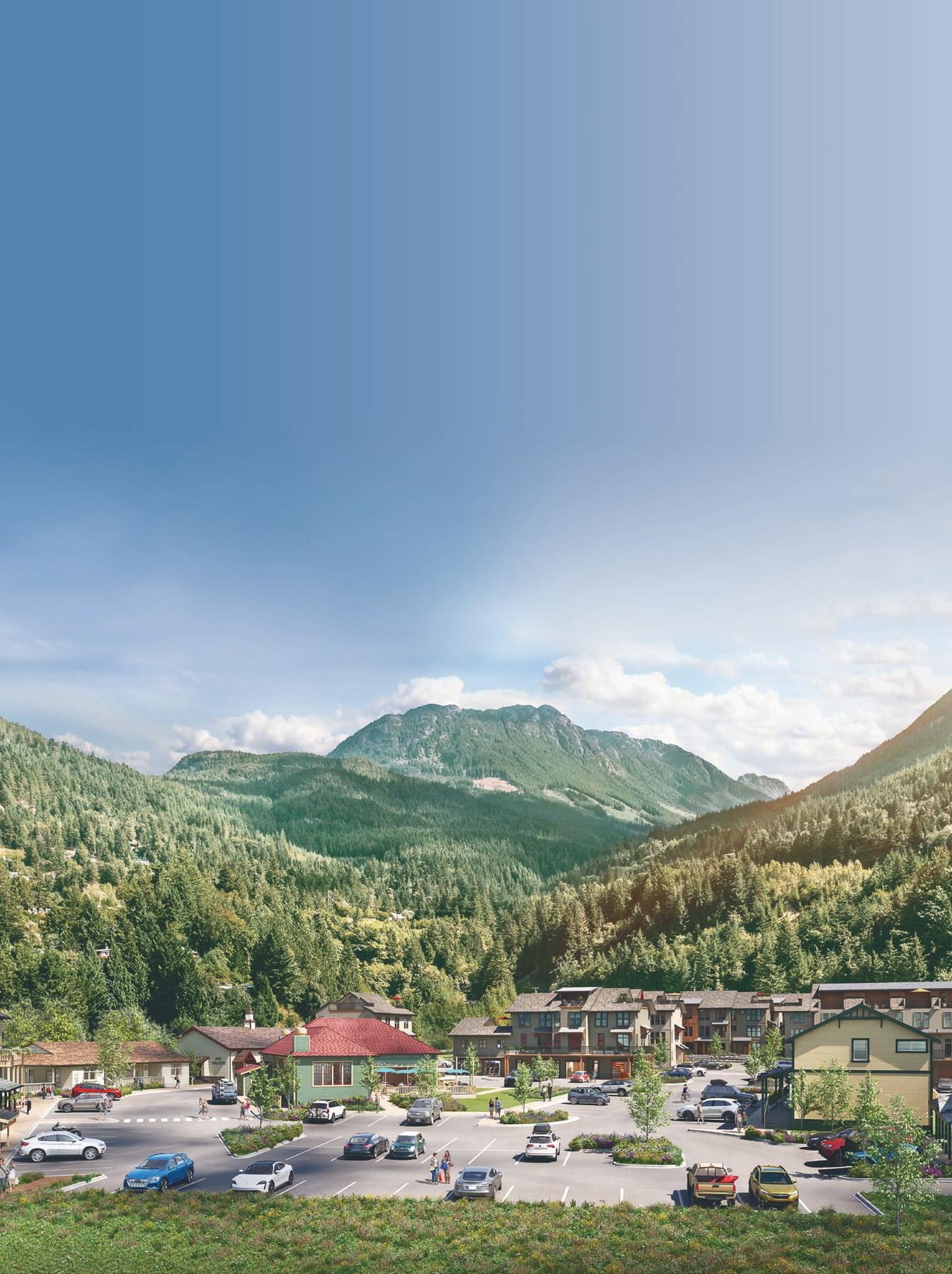
Register today at britanniabeachliving.com


New Displays & Presentation Centre | Open Daily 12pm - 5pm 351 Copper Drive, Britannia Beach


WHILE MANY PEMBERTONIANS seem to appreciate the close-knit community, natural splendour and recreational opportunities currently at hand, recurring issues like growth management, affordable housing, climate change and lack of public transportation continue to cause concern.
On April 11, elected representatives of the Village of Pemberton (VOP) heard a presentation summarizing the early findings of public engagement efforts in Phase 1 of the village’s Official Community Plan (OCP) Review. Delivered by community planner Melissa Clements of the consulting firm Urban Systems, the full “What We Heard” report is freely available online.
From Jan. 16 to March 10, locals had the opportunity to pick up Kitchen Table Discussion Kits and host their own conversations about Pemberton’s future. These activities complemented a Community Open House on March 6, which gave attendees a chance to further discuss relevant issues.
When Kitchen Table participants were asked what, in their view, will be Pemberton’s greatest challenge over the next 25 years, five key areas emerged. Out of a total of 215 comments, 33 identified growth management and preserving the village’s uniqueness, while 27 others were concerned about infrastructure. Other salient topics included climate change (21), transportation (18) and
affordable housing (16).
Pembertonians also shared various opinions on what they want their town to look like in future years. Thirty-two comments expressed desire for more recreational facilities (such as a pool, ice rink or Nordic Centre), and 24 highlighted the protection of local food systems. Twenty-one were mainly concerned about the development of regional transportation, while the issues of affordability and natural conservation were mentioned in 18 comments apiece.
On the bright side, 71 responses appreciated Pemberton’s “sense of community,” although it is not clear what was specifically meant by this term and whether it differs across demographics. Forty-one respondents lauded easy access to the outdoors, and 34 others were grateful for the area’s natural environments.
Meanwhile, the Open House facilitated small group discussions about four major topics: reconciliation, environmental sustainability and community resilience, the local economy, and housing.
In terms of reconciliation, 11 comments discussed the VOP providing more opportunities for dialogue with First Nations people, 10 wished to promote inclusivity by co-developing area policies and nine would encourage residents to learn more about First Nations history and culture. Clements agrees that more is needed in that area.
“We just need to develop a really good understanding of what [Lillooet Nation’s] expectations are … and then work towards those,” she said.
The greatest common theme regarding environmental sustainability was the
prioritization of emergency response planning against natural disasters (13). Awareness of environmental issues (5), effective waste management (5) and the need for more public transit (4) were also raised.
Eight comments expressed the view that more affordable housing and/or staff housing would be an ideal way to stimulate the local economy. Six others wanted to see more eco or adventure tourism, while five thought that Pemberton’s location and existing recreational offerings could be leveraged.
Regarding the ever-present question of housing—in many ways the hottest topic explored at the Open House—nine responses highlighted prioritizing affordable accommodation (including rentals), while five hope to see more support for first-time home buyers and four believe that more staff housing is needed.
Open House attendees also suggested that Pemberton might establish its own housing committee, analogous to the Whistler Housing Authority (WHA).
VOP staff later issued a clarifying statement on the matter.
“Pemberton and Whistler are different in that Whistler is a resort municipality and has the benefit of large land holdings, as well as a bigger tax base that helps support the implementation of initiatives like a Housing Authority,” the statement read. “Pemberton does not have the land or tax base as such consideration needs to be made in terms of whether a Housing Authority could work in the same format as Whistler.
”It is important to acknowledge the community’s desire to find a solution for housing issues in Pemberton, although it is just as important to explore the right solution that is best for Pemberton.”
The “What We Heard” report and other relevant feedback will be used to draft a vision statement, guiding principles, goals, and objectives for the new OCP, which is intended to guide Pemberton policy into the year 2050.
Phase Two of the OCP Review is slated to begin this June and continue until January 2024. During this time, VOP councillors and staff will focus on policy development. Community members will be able to provide further input at various summer events and another Open House this fall.
A housing discussion paper will also be released at the beginning of Phase 2, which according to VOP staff will report on existing feedback and better the community’s understanding of what conditions are required for housing authorities to be successful. Exploration of other affordable housing options will be informed by a Housing Needs Report due in June.
A total of 166 Pembertonians visited the Open House, while 142 involved themselves with Kitchen Table Discussions. Both groups were predominantly female homeowners: 63 per cent of Open House attendees (out of 43 individuals surveyed) identified as women, 86 per cent owned their residence and 37 per cent were between the ages of 45 and 54.
Similarly, 71 per cent of Kitchen Table participants (out of 123 surveyed) were female, 83 per cent were homeowners and 31 per cent were 45 to 54 years old.
Social media has by far been the most popular method of engagement, with OCP Review content getting 14,635 views as of April 11. The official OCP website, haveyoursay.pemberton.ca/ocpreview, has garnered 809 visits. n
OPEN DIALOGUE A total of 166 Pembertonians attended an OCP open house at the Pemberton and District Community Centre on March 6.LOCAL POLITICIANS may soon see a pay increase at the regional level as the SquamishLillooet Regional District (SLRD) board will consider increasing the salary for its four electoral area directors by $20,000 over the next four years.

SLRD area directors discussed the resolution at the April 5 electoral area directors (EAD) meeting.
If approved, it would increase the salary for the district’s four area directors by $5,000 in both 2024 and 2025 and another $10,000 in 2026 (prior to the next municipal election).
Area directors currently earn about $34,000 annually, though the chair of the EAD board earns an extra $3,840.
The resolution came from Area D Director Tony Rainbow, who has led the charge on increasing the directors’ salary since the end of the previous term, citing the need to bring a broader range of people into the role.
“I can afford to do it because I have a pension, but if our stipend stays as low as it is, you’re basically restricting electoral area directors to people who are independently wealthy, business people who can afford to take 25 to 40 hours off a week ... or someone who has a full pension,” Rainbow said at an SLRD board meeting last September.
The pay for regional district directors varies wildly across the province. In the Central Kootenay Regional District, the salary ranges from $45,000 to $50,000 per representative, while in the Peace River Regional District, that average drops to about $20,000 per representative.
For comparison, in Whistler, municipal councillors earn $48,798 annually, and in Pemberton they take home about $15,405.



However, councillors in both municipalities receive an additional stipend of $17,111 if they serve as representatives on the SLRD board (as well as an additional $14,677 for the SLRD board chair, and $2,434 for the vice chair).
According to the 2021 census, there are 6,470 people in the SLRD’s four electoral areas: 305 in Area A; 1,624 in Area B; 3,492 in Area C; and 1,057 in Area D. In a few of these rural areas, the population has risen by a significant margin, adding new challenges for elected officials, and increasingly making the job more of a full-time gig.
In tandem with population growth over the last few years, several large-scale developments are proposed or approved in the electoral areas. These include a massive new ski resort at Mount Garibaldi; a surf park south of Britannia Beach; the expansion of WedgeWoods north of Whistler; and, more recently, the development of Furry Creek.
These projects could see hundreds of new homes built in rural areas over the next decade, increasing both the complexity of the position and population of the regions they serve.
While the current area directors will profit from this decision, the goal is to bring “young blood” into the role, as Area A Director Sal DeMare put it, and encourage more people to put their names forward for the position in the next election.
“[W]e want this to show other people out there that we’re going to have some increases at the next election,” DeMare said at the April 5 EAD meeting. “We’d like to get new blood into electoral areas. For some people that look at $30,000 or $33,000 compared to $50,000, maybe [that will] change your minds and [get people to] say, ‘Yeah, that could be a career I can be doing.’ So that’s the reasoning behind it.”

The SLRD board will consider the pay increase at a future meeting. n
Whistler Olympic Park volunteers, thank you for your tremendous support to our non-profit organization this winter. Your help and energy provided a great experience to our recreational cross-country skiers, snowshoers and the Nordic community!


This season we were able to offer 137 days of skiing! You assisted our guest services and patrol teams, helped maintain our snowshoe trails, provided information to guests and helped support our school program which saw 2,400 skier v isits from local school children from Kindergarten to grade 12.
An additional thank you and congratulations goes to the tremendous efforts by those who volunteered for the many biathlon, cross country ski, ski jumping and Nordic combined events, this season’s highlight being of course the FIS Nordic Junior World Ski Championships in January and February, featuring the world’s best young Nordic athletes.
Finally, thank you to the many volunteers who facilitate programmin g and events for local Nordic clubs and community partners
Volunteers keep Whistler Olympic Park rooted in the local community, and your support is of immeasurable value to our Nordic family and to our mission to grow sport in the Sea to Sky region.
Have a wonderful summer and see you next season!
Tim Hope, Whistler Olympic Park Managing Director & Team SWEETEN THE POT Elected officials at the Squamish-Lillooet Regional District are considering a salary increase as a means of attracting more interest at the regional district board.
Every year in April, Canada celebrates National Volunteer Week. The annual occasion offers a chance for people nationwide to praise the collective impact of the millions of Canadians who freely give their time to important causes.
For more than two decades, Whistler Friends (Community Health and Welfare Society) founder Dave Clark has organized dozens of fundraising events for charitable causes, from the annual Balding for Dollars event that helps fight cancer to the upcoming Whistler Half Marathon, which supports Crohn’s and Colitis Canada.
Pulling off a large-scale event like the Whistler Half Marathon, with more than 200 runners making their way through the resort, is no easy task, but according to Clark, the key to the success of the events is the support from volunteers.
“All those events that I was involved in, to various degrees, have a volunteer element to them. I’ve been super fortunate to work with a lot of really great groups of volunteer people over the years, and events from the largest
scale, like the Olympics, down to the smallest scale, like Balding for Dollars,” Clark said. “None of those events could happen without volunteer time. It really is the nuts and bolts of every event I’ve ever been involved in.”
Throughout the Whistler Half Marathon weekend, Clark aims to fill about 125 volunteer shifts, with a need for people to help at aid stations, work as course marshals, set up and tear down, and perform various other tasks, like cheering on the athletes. Year after year, people return to help at the event.
“We have a number of people that come back year after year because they just want to be part of the event,” Clark said. “They enjoy it. They think it’s fun. They like coming out, seeing the athletes, and supporting them. Whatever their driving factor is, they like to come back.”
Retaining and recruiting volunteers is a challenge at the best of times for many volunteer-dependent organizations, but this task has grown increasingly difficult in the wake of the COVID-19 pandemic.

Volunteer Canada found in a recent survey that 65 per cent of volunteerreliant organizations across Canada have experienced a decline in the number of people
signing up to volunteer in the last three years, while the demand for services has increased by 32 per cent.
Jaye Russell, executive director of the Sea to Sky Community Service Society (SCSS), has seen this decline in volunteerism directly as the COVID-19 pandemic significantly impacted volunteer recruitment.

“Certainly, we’ve been feeling that [decline],” Russell said. “I mean, let’s not forget that COVID had a huge impact on our organization’s and many organizations’ ability to recruit and maintain the support from our volunteers.”
While the number of volunteers has declined since the pandemic, Russell noted that many new volunteers who used to commute to work and now work remotely are signing up to volunteer in growing numbers, using their additional time to connect with the community.
“Worldwide, we’ve certainly seen a decline in volunteerism. However, we are seeing a resurgence in interest in volunteerism solely from the context of folks who are working remotely, who maybe have stayed working remotely post-COVID,” Russell said. “They’re not commuting to and from the city, and they


have more time to give back.”
According to Russell, the SCSS needs between 50 and 60 volunteers in a typical year to support its programs. It also requires more volunteers to help with the Pemberton foodbank and the Better at Home program, especially as demand for these services continues to rise
“By and large, we know that population increases in the corridor have certainly increased service demand. And we’re seeing that not necessarily specific to a pinpointed program, but in general. We’re seeing increases year over year of increased service demand,” Russell said.
“Now more than ever, it’s important that organizations like [SCSS] re-engage the community in a conversation about how they see themselves giving back to the community, [and] how they see themselves getting involved in the community.”




If you’re interested in volunteering, the best way to get started is by contacting the organization or event you’re interested in online and letting them know why you want to help.
National Volunteer Week takes place from April 16 to 23 this year.


We are grateful to all the Hospice Volunteers who assist us supporting community through life limiting illness, through caregiving and through grief.




Thank you for taking time to visit, to walk, to listen, to stitch quilts, make calls, sew celestial bags, facilitate bereavement an caregiver groups and advocate for dignity, care and compassion through end of life.
YOU offer that extra layer of support
We cele brate and t hank You!
olunteer@seatoskyhospicesociety.cca

The team at the Audain Art Museum extends a sincere thank you to our dynamic and dedicated team of Volunteers, Educators, Docents, and Committee Members!
The involvement of these passionate individuals is critical to the overall Museum visitor experience.

The AAM is thrilled to be once again welcoming new Volunteers to share their knowledge and expertise. If you are interested in contributing, our team would love to hear from you!



Email connect@audainartmuseum.com to l ear n more about becoming involved.


audainartmuseum.com

To our passionate and dedicated volunteers

Thank you for your time, your energy and your skills in supporting WCSS all year long.
You make all the difference to our community. We couldn’t do it without you

During National Volunteer Week we want to thank and celebrate you – our wonder ful Village Host and Bike Host volunteers!
These last few years have been different and challenging. We have learned to adjust and to pivot, and to do things in new ways

Through all of this you continued to be dedicated, friendly and caring. You gave freely of your time and your knowledge. You suppor ted businesses and visitors, and helped to keep us safe. You are an integral and impor tant par t of Whistler’s passionate and engaged community.
YOU ARE INVALUABLE AND WE ARE SO GRATEFUL!
Village Hosts
Lynn Ashton
Mar y Beadon
Sylvia Brandt
Sue Brown
Rosemar y Cook
Sandy Culpitt
Patricia Dagg
Sharon Doiron
Lisa Donahoe
Judith Dyer
Marilyn Fell
Doug Fell
Karen Gardner
Tonnie Van Ginkel
Bruce Hall
Heather Hall
Jon Harper
Liz Har vey
Anne Hibbelin
Lorna Hill
Sorca Holmes
Adrienne Hughes
David Hughes
W E L V E O U R


VO LU N T E E R S !
Kirk Hulse
Janice Hulse
Alison Hunter
Jaquie Jennings
Daniel Jonckheere
Sue Kelly
Tim Kelly
Sherr y Klassen
Mar y Ann Kumli
Jinny Ladner
Sarah Leyshon Hughes
Audrey Lundie
Kevin McFarland
Ken Mar tin
Sheilagh Mar tin
Karina Meik
Christina Merer
Ruper t Merer
Robin Nichols
Barb Oliver
Chris Patrick
Michele Radnidge
Jill Rowledge
Gail Rybar
Carol Severson
Trish Sloan
Judi Spence
Susie Spiwak
Helen Stanley
Patricia Stoop
Len Van Leeuwen
Tonnie Van Ginkel
Margaret Waller
Tom Waller
Anita Winkle
Ted Winkle
Liz Whelan
Dan Whelan
Bike Hosts
Don Armour
John Champion
Jon Condon
Iain Grunwell
Ernest Leyshon Hughes
Roger Lundie
Jay McKenzie
Barb Radlgruber
Brad Sinclair
Whistler Public Library would like to thank our Materials Management Volunteers, our Board of Trustees, and the Friends of the Library for their unwavering support.





THANKS TO YOU WE ARE CELEBRATING 17 YEARS! OF SERVICE TO THE WHISTLER COMMUNITY





























On behalf of all of the staff and residents at WAG, we’d like to recognise and thank our kind hearted volunteers who dedicate their time to animals in need throughout the year!




This year has already been full of change at WAG, and that doesn't seem to be slowing down anytime soon! What hasn't changed is we've been busy, and we couldn't do it without our amazing volunteer team Our shelter volunteers with regular weekly shifts come by for some form of either cat enrichment or dog enrichment shifts The former involves playing with the felines, while helping maintain a high standard of cleanliness in their rooms while the latter includes going out for walks, playing in the yard, cuddling inside, and if we have puppies - lots of cleaning! That's only the tip of the iceberg and the part that most people think of when they think of volunteering at WAG Our dedicated foster homes take on the hardest cases whilst they seek their forever homes, with help from our superstar drivers and our partner Vets to ensure our animals get the medical help they deserve Thanks to our Vet's we can continue to help pets in more remote areas stay with their families via our annual Wellness Clinic's and low cost Spay and Neuter programs Last but not least, we want to thank our Volunteer Board of Directors at WAG This group of selfless individuals lend their expertise and experience in a wide variety of areas to guide and advise us We are so fortunate to have you!



























UP UNTIL ABOUT 400 years ago, it was widely accepted that Earth was at the centre of the universe, and everything revolved around it. When scientist Galileo Galilei challenged this “geocentric” view—confirming Nicolaus Copernicus’ “heliocentric” theory that planets revolve around the sun—he was charged with heresy by the Catholic Inquisition, a crime punishable by death. In 1633, he was sentenced to life imprisonment.
Galileo died under house arrest in 1642, but the Church didn’t lift its ban on heliocentric works until 1757. Despite the evidence, heliocentrism threatened a world view that put humans at the centre of “creation.”
BY DAVID SUZUKIUnderstanding of our place in the cosmos may have advanced considerably over the past few hundred years, but we’re still largely operating from an “anthropocentric” (human-centred) if not geocentric mindset. That is, we see humans as the pinnacle of existence, on a level well beyond that of other life.
That perspective is also facing challenges in light of growing scientific evidence. In Western culture especially, plants and animals
Empires that Run the World, says, “Honeybees understand the concept of zero, can add and subtract numbers and can even be trained to detect land mines more effectively than sniffer dogs.” And some bumblebees “can be taught to play soccer, and remember good and bad experiences, suggesting they have a form of consciousness.”

As for crows and other corvids, research shows they “know what they know and can ponder the content of their own minds,” which is “a cornerstone of self-awareness and shared by just a handful of animal species beside humans, such as monkeys and great apes,” a Popular Mechanics article reports. They can “also use their complex brains to find creative solutions, such as dropping nuts on the road so passing cars can crack them open.”
We’re also learning that plants have complex abilities that allow them to communicate and care for each other. Research by scientists such as Suzanne Simard at the University of British Columbia, popularized in books by Peter Wohlleben and others, including me, show that trees share nutrients through fungal networks and can warn each other of threats.
New research has found that some plants emit high-pitched sounds when they experience stress from damage or dehydration. Although these are at frequencies humans can’t hear, they could theoretically be detected by other animals.
have long been considered rudimentary life forms, incapable of the advanced cognition and communication skills of humans. That’s given us justification to exploit nature without much thought about the consequences.
But scientific research is starting to confirm what many Indigenous Peoples have long known: that other life forms, and perhaps even non-living things, are as much our kin as they are objects to be used for our purposes.
From sentient bees to self-aware crows to plants that call out when they’re stressed, the living world is turning out to be far more fascinating and complex than we imagined.
Stephen Buchmann, a pollination ecologist and author of What a Bee Knows: Exploring the Thoughts, Memories and Personalities of Bees, has studied bees for more than 40 years. He argues that these tiny insects “can demonstrate sophisticated emotions resembling optimism, frustration, playfulness and fear” and “can experience PTSD-like symptoms, recognize different human faces, process long-term memories while sleeping, and maybe even dream,” the Guardian reports.
Oliver Milman, a Guardian writer and author of The Insect Crisis: The Fall of the Tiny
Although there’s “no evidence that the plants were making the sounds on purpose,” researchers were able to distinguish between the different plants and the types of stress they were experiencing by the rate of sounds, according to Smithsonian Magazine
What much of this research shows is that we have been, and still are, operating on a limited understanding of nature and how it’s all interconnected. We don’t stand outside of or above nature; we’re part of it. This is why many Indigenous Peoples regard nature as “kin” to which we are connected rather than “resources” to be exploited.
We’ll no doubt continue to learn more about the world around us, which will necessarily change our perspective. We rely on nature for sustenance, but even the limited knowledge we have shows that we must fulfil our needs with greater humility and respect for all existence.
David Suzuki is a scientist, broadcaster, author and co-founder of the David Suzuki Foundation. Written with contributions from David Suzuki Foundation Senior Writer and Editor Ian Hanington. ■

New research has found that some plants emit high-pitched sounds when they experience stress from damage or dehydration.
SINCE MOUNTAIN BIKING and hiking season is nigh, and many have already been out-and-about in Squamish or Pemberton when not enjoying the current primo mid-winter conditions on our mountains, it’s time to re-up some thoughts I’ve touched on before about trails—who uses them and why, and what we should keep in mind when building them.

Most outdoor adventures involve “trails” of some kind. Whether mountain biking, hiking, climbing, or even canoe-tripping, our
BY LESLIEendeavours usually follow previously tracked lines on the map. Humans have been creating trails forever, and in some places still employ them not for play, but the age-old search for water, food, and seasonal relocation. If this sounds much like what other animals do, you’re correct. In fact, animal (and, once upon a time, human) movement is the primary behavioural adaptation to the variability of critical resources in time and space.
For animals, biologists categorize movements into functional groupings such as foraging, dispersal, or migration, and study them with a range of modern technologies like radio telemetry, satellite tracking, remote-triggered cameras, and drones. The data accruing from these tell us one thing about animal movements: trails are superhighways for a range of terrestrial

species from insects to megafauna.
As human societies evolved, trails connected us to other groups of humans. Pre-existing animal trails often comprised the most direct routes, but animals were also more than happy to use the passages we created to expand their own movements. This reciprocation continues.
In most cases, human use of longstanding forest trails doesn’t negatively affect the likelihood that other animals will use them (though some ungulates will associate certain trails with hunting danger), however, human activity can lead to changes in animal behaviour and distribution patterns
wouldn’t, they also become dispersal corridors for plants, which co-opt animal travellers as vectors to move their seeds—whether stuck to fur, or seeds consumed at one sunny spot and defecated out at another.
A concentration of plant food sources along trails can attract herbivores (e.g., deer), in turn providing reason for sit-and-wait predators (e.g., mountain lions) to hang around. We need to remember how much biological industry and behaviour our trails actually subsidize when we “suddenly” find it interfering with our own use—like startling a bear munching on berries that wouldn’t otherwise have grown there save for the trail’s interruption, or a
should be built so as not to cut between adjacent denning, reproductive, thermoregulatory and foraging habitat, all of which may be in a tiny area. Currently, Veronica Woodruff of Stewardship Pemberton is working with PORCA to reroute parts of some longstanding trails from the critical habitat they once cut through; the resulting detours are short, but effective for ecological restoration.
Trails also facilitate the movement of destructive invasive plants—both by wild animals and humans. We might not have fur, but easily carry plant seeds on our clothing, shoes and even tires (there’s even a name for this—anthropochory). Next time you start a hike or bike at a popular trailhead, take note of how far dandelions and other invasive plants follow the trail.
if the level of activity is high enough to cause disturbance. Traditionally trained trailbuilders keep this in mind, but it’s something many enthusiastic builders of today’s (mostly illegal) mountain bike trails don’t consider—or are even aware of. That needs to change given the ever-increasing impacts on ecosystems and wildlife everywhere, but particularly in the Sea to Sky.
To start, we’re most familiar with the trails of larger animals (ourselves included) yet pay little attention to their finer ecological points. For instance, well-used forest trails create space for flying insects, birds and bats to navigate the understory, supporting a food chain based on “edge” plants and the dung of the animals using those trails. Because trails allow light to penetrate where it often
snake using a nice warm mountain-bike trail to stretch out in the sun.
The problem compounds because human trailbuilders tend to enjoy the same types of places as sensitive ecosystems—south-facing slopes and meadows, open-canopy forest, and wetland, river and lake margins. Here, biologists can help meliorate environmental impact by showing where a trail might be routed so as not to come close to areas that might contain ground-nesting birds or reptile dens, or not to cut off such habitats from other areas utilized by these same creatures.
A good example in Pemberton is the highly endangered sharp-tailed snake, a burrowing, pencil-thin slug-eater that might be only a foot long in adulthood with a home-range radius of only 50 metres; where these animals occur, trails
And it isn’t only riding that leads to this unholy seeding, but trailbuilding itself— particularly unsanctioned construction by non-professionals—given how easily noxious invasives like thistle, knapweed, burdock and orange hawkweed are spread by clothing, footwear, transported soil and uncleaned tools. Looked at this way, trailbuilding without undo concern for biological impacts can be like sending an IV drip of eco-destruction from über-disturbed frontcountry into pristine backcountry.
In the end, we tend to see trails we either modify or create as our own, but they never remain exclusive. Whether in use before we found them, or new routes now subsidizing the movement of other wildlife, it behooves us to treat trails as shared natural spaces with potential real impacts, and respect that while for us they may be a means to adventure, other organisms still count on them for their livelihood.
[I]t behooves us to treat trails as shared natural spaces with potential real impacts...
ANTHONYWHOSE HABITAT IS THIS? The Sea to Sky Trail south of Whistler.
Thursday, April 27, 2:00PM Whistler Conference Centre






Housing a local workforce is among the most pressing matters facing mountain resorts today.
Moderator industry expert panel discussions on mountain resort housing throughout North America which will then be followed by an engaging audience Q&A session.


The bold move makes good on a campaign promise of the NDP government.
It’s the focus of sustained activism of groups like AccessBC and Action Canada for Sexual Health and Rights, and was ignited by the ongoing abortion politics south of the border, where a judge in Texas just issued a preliminary ruling invalidating the Food and Drug Administration’s 23-year-old approval of the abortion pill mifepristone. That ruling was almost immediately followed by a contradictory decision by a judge in Washington state.

The B.C. policy could serve as a model for other provinces—Ontario’s Progressive Conservative government, for example, has already said it’s “looking closely at what British Columbia has proposed.”
Nonetheless, universal coverage of contraception beyond British Columbia is unlikely at the moment. It does not seem to be a serious proposal of any current provincial government.
While some provincial opposition parties have promised universal contraception, policy progress depends on whether they actually get elected. It will also depend on a number of factors that will shape their political agenda once in office.



















The new coverage in B.C. is extended to anyone with a provincial health card and requires a physician’s prescription until later this spring, when pharmacists will be able to prescribe contraceptives.
The list of contraceptives included in this plan is comprehensive but not exhaustive. Other forms of birth control and menstrual regulation, according to the B.C. government, might be considered in the future.
There seems to be no significant discussion of extending the coverage to B.C. residents who don’t have a provincial health card, such as undocumented residents and migrant workers for whom reproductive rights are already sometimes inaccessible.

And accessibility will be dependent upon pharmacists’ willingness to dispense medication, something that might be particularly contentious, not to mention time-sensitive with emergency contraception.
Pharmacists are allowed to refuse to stock or dispense medication as a matter of conscience, something that has been a barrier for medication abortion access in Canada, especially in rural areas. Yet despite these criticisms, the B.C. plan serves as an example of equitable primary sexual and reproductive health care delivered at the provincial level.
Opposition parties in Alberta, Manitoba and Saskatchewan have all promised to implement the same policy if elected. But at this point, such a commitment really just amounts to a progressive idea in the context of conservative provincial politics, with centre-right parties in
power in eight of 10 provinces.
This means that the B.C. policy might reflect the uniqueness of the province’s political dynamics and also demonstrates what is possible, given the right political conditions, in the realm of reproductive rights.


It’s also reflective of the broader North American politics of abortion, as the timing of the policy—a campaign promise of the NDP government, elected in 2020—seems to respond to the reversal of reproductive rights in the United States with the overturn of Roe v. Wade in June 2022.





The end of constitutional protection of the right to abortion in the U.S. created momentum for strengthening abortion policy and reproductive rights in Canada.
In response to the U.S. Supreme Court ruling, the federal Liberal government has increased and sustained commitments to ensuring access to abortion and other areas of sexual and reproductive health and rights.
The same organizations that benefit from increased federal funding—and use it to support women and other pregnant people—indicate that Canadian women who used to travel to the U.S. for certain kinds of abortions are finding it more difficult to do so due to increased restrictions and bans on the American side of the border.
The recent duelling U.S. court decisions concerning restrictions
on mifepristone will only increase this






difficulty and limit reproductive rights. Policies like B.C.’s universal coverage of contraception will help to expand reproductive rights. That’s why it’s such an important decision.






On a practical level, funding for contraception has the effect of making birth control available for everyone, with no privilege for those who have private insurance or can afford to pay and no disadvantage for those who have trouble affording it.
But beyond this, public support and payment for contraception serves to normalize birth control, Plan B and sexual health and reproductive rights as a public good and as a matter of public responsibility.
In an age of increased privatization in health-care in general, and the increased stigmatization and criminalization surrounding abortion, the B.C. move is a positive step that fully embraces sexual and reproductive health and rights for everyone in post-Roe North America.
Candace Johnson is a professor of political science at the University of Guelph. This story originally appeared at The Conversation on April 1, 2023. Find it at theconversation.com/british-columbiascoverage-of-contraceptives-should-inspire-the-rest-of-north-america-203131. ■
As of April 1, 2023, all residents of British Columbia gained access to free prescription contraception. This includes the birth control pill, injections and implants, IUDs and emergency contraception known as Plan B or the “morning after” pill.
The end of constitutional protection of the right to abortion in the U.S. created momentum for strengthening abortion policy and reproductive rights in Canada.
THE 18-YEAR-OLD WHISTLERITE ‘COULDN’T HAVE ASKED FOR ANYTHING BETTER’
BY DAVID SONGTHOUGH STILL A teenager, Marcus Goguen is already a competitive two-sport athlete, a world champion, and a podium finisher at the highest level of freeride skiing: the Freeride World Tour (FWT). He’s had a banner campaign, and he’s just getting started.
“I couldn’t have asked for anything better, honestly,” Goguen said. “[The most I expected] for the season was just doing well on the challenges and then at the end, qualifying for the [FWT] the following year. I never really expected to get a wild card onto the tour as an 18-year-old.”
The Whistlerite has had plenty to celebrate this past year. Back in August, he won a bronze medal and the Stevie Smith Memorial Award at Crankworx on two wheels. Months later, he co-starred in a Warren Miller snow sports film called Daymaker, which helped to elevate his profile as a talented young skier.
Then, in January, Goguen elevated
himself to the podium’s top step at the 2023 Freeride Junior World Championships (FJWC) with a high-amplitude run under pressure.

“I definitely had the goal of doing a solid run that I’d be happy with,” he remembers about that milestone day in Austria. “Obviously, I had the top spot in mind, but I definitely just want to have fun and experience skiing in Europe. That’s what I did, and it worked out.”
Shortly afterwards, Goguen flew across the pond to Spain, where he was to forerun for the FWT’s season-opening event in Baqueira Beret. He had landed the gig through Derek Foose, a tour announcer and head coach of the Whistler Freeride Club (WFC) where Goguen cut his teeth in the sport.
After acquitting himself well as a forerunner, Goguen felt like he fit right in with the older, more experienced athletes on the big show. They, in turn, were impressed with his clutch performance at the World Juniors. FWT decision-makers awarded the Whistlerite with a wild card spot on the senior circuit, and he took full advantage.
A ninth-place finish at Ordino Arcalis in Andorra showed the world that Goguen was ready for freeride’s grandest stage. Later in February, he threw down his first FWT podium performance at Kicking Horse in Golden, B.C.
In doing so, Goguen bested Austria’s Valentin Rainer, who ended up third in Kicking Horse but became the overall World
Champion at season’s end.
“To be honest, that wasn’t really one of the runs I was super stoked on this season,” said Goguen, who nonetheless managed to distinguish himself with a big 360 followed by a hard left turn into a daring backflip. “It was just such a short and quick run. All of a sudden, I was down [at the finish] and it all happened so quick. I didn’t even realize what happened.
“Obviously, I’m happy. It was really cool to have my first time sitting in the hot seat in the big leagues, and I was pretty stoked to watch my buddy [Max Hitzig of Germany] throw that massive backflip, kicking me out of the hot seat [and winning].”
Goguen wrapped up his season in 10th in Fieberbrunn, Austria as the field’s lone Canadian. The Yeti Xtreme Verbier contest (originally meant to be the FWT finale) was then cancelled due to adverse weather.
Last year, Goguen recognized that he may ultimately need to choose between his two beloved sports of skiing and mountain biking. He is more dominant on powder and knows that his competitive ceiling lies within the ski world.
Even so, the reigning FJWC king intends to make his name as a dual-sport athlete. As a member of the Outlaw United bike team, he’ll be headed back to Europe in June to race in several World Cup downhill events.
Goguen believes it is healthy for him to focus on different sports in different seasons, as just one can get “kind of boring.”
He’s certainly not alone. Whistler is home to a bevy of competitive youngsters with aspirations of all-terrain greatness. Take the Pelchat sisters for example: Juliette and Amalia are both snowboarding standouts who also run the Real Wild Kittens (RWK) skateboard club.
Then there’s Whistler’s favourite youth athlete, Wei Tien Ho: a Norco Canadian Enduro Series-winning mountain biker who recently earned his shot on the FWT.
Goguen and Ho are childhood friends who grew up shredding their way through snowy slopes and dirt trails alike. They remain close, and Goguen says that Ho has inspired him to not only continue biking, but to push himself in the sport.
Needless to say, he’s thrilled to be taking on the world’s most picturesque mountains alongside a trusted friend. The two are accustomed to competition, but Goguen expects them to lean on each other during their time on the senior circuit.
“I think we can both succeed out there, for sure,” he said. “There’s definitely going to be a competitive nature between the two of us, but I think it can be more as teammates. You look at the Swedes, where they’re always picking lines together on the Freeride World Tour.
“[Ho and I] would be able to have that kind of team going forward with each other and work together to succeed.” n
GO GETTER Marcus Goguen poses for cameras after finishing ninth on the Freeride World Tour’s Ordino Arcalis contest in 2023.
THE 13-YEAR-OLD FREESTYLER IS COMING OFF A DECORATED SEASON AT THE BC WINTER GAMES AND TIMBER TOUR
BY DAVID SONGDON’T LET HIS youth fool you: Jude Oliver knows his stuff.
At 13 years old, the Whistlerite already thinks about his chosen sport at a high level. While casual viewers tend to be blown away by big tricks with lots of rotations, he has an eye for detail—putting the “style” back in “freestyle skiing,” if you will.

“It matters if you’re controlled in the air. Stomping [your trick] really hard is way better than landing it, kind of, and then slipping out,” Oliver explained. “And say if you’re competing at the X Games and you ‘tickle the grab,’ which means you barely touch [your skis], it scores you way less.
“If you land a switch dub 10 with a clean Japan grab, it would score way more than a switch dub 21 with no grab.”
That’s gibberish to anyone who doesn’t follow freestyle skiing, so allow me to explain. A 10 (or 1080) is a trick where an athlete performs three full rotations, and a 21 (or a 2160) is six full rotations. It took until the 2022 X Games for any skier—that athlete being Alex Hall of the United States—to successfully land a 2160 in competition. That’s how hard it is.
Yet, Hall’s sport-defining surge into history was only rewarding because he executed his grab, locking both hands firmly onto one ski while in the air. Amplitude and spectacle are not enough in the freestyle world—one must also be technically sound, and grabs are an important way to prove that.

Oliver understands the importance of proper execution on course, which is why he and fellow Whistler athlete Emma Horn were named this year’s recipients of Freestyle BC’s “Style Matters” award.
A press release promoting the accolade reads as follows: “The most stylish skier makes it look like they are flowing down the mountain, casually dancing with gravity at death-defying speeds while being entirely in control.”

Neither Oliver nor his family saw the award coming, yet he and Horn were honoured during a late February Timber Tour event in Fernie.
Perhaps carrying some extra confidence, the young Whistlerite struck double gold at the BC Winter Games in slopestyle and big air, his favourite disciplines. Two other Sea to Sky youths joined him on those podiums: Elijah Krumme took silver in slopestyle and Mavik MacKinnon came through with big air bronze.
Next, Oliver concluded his campaign decisively with a three-medal showing at SilverStar Mountain Resort for the Timber Tour’s BC Championships. Again he emerged victorious in big air, while locking up slopestyle silver just ahead of Squamish
native Krumme.
Oliver also earned bronze in moguls, an event he admits he’s not fond of.
“I was definitely very surprised,” he said. “I was putting something away in the garbage, and I just heard my name be called. And I was like: wait, isn’t this the moguls category? How did I do this? Oh my gosh!”
Yet for Oliver, winning isn’t the whole picture. He views competitions as a great way to connect with friends old and new. Furthermore, he values his overall progression as a skier more than individual medals.

The hardware is a bonus, but it’s the journey that matters most.
“We’re always super proud of Jude,” said Oliver’s mom, Louise. “You know, those medals don’t come easily. He puts in a lot of hard work. It’s not like he just shows up and wings it.”
Oliver joined Freestyle Whistler shortly after his first contact with the sport at the age of six. He has blossomed under the tutelage of veteran coaches like Brandon Fritz (a.k.a. Fritzy) and Connor Broderick alongside other talented youngsters like Krumme, MacKinnon, Ty Reichert and Jacob Martin. (Reichert and Martin finished eighth and 10th, respectively, at the BC Winter Games slopestyle event).
“Fritzy definitely is an inspiration and a good role model because he’s always super hyped to be on the hill, same as Connor,” said Oliver. “Even if me or my teammates are down, they’re always just willing to pick us back up and be like: OK, you’re not having the greatest time doing this trick right now. Go ahead and try a different one that you’ll have fun with and come back to it later.”
In addition to Fritzy and Broderick, Oliver looks up to Olympic-calibre standouts like Mac Forehand, Jesper Tjäder, and Hall— who coached him at Momentum Ski Camps last summer. Another role model is Aidan Mulvihill, a Freestyle Whistler alum who now competes for Team BC

Louise admits to getting scared, watching her son throw himself off of jumps and rails. Despite that, she has acclimated well to being a freestyle parent.
“I was at all the competitions Jude went to this season, and I forced myself to keep my eyes open,” she said. “I’m definitely buddies with Stephen and Cheryl, Ty [Reichert’s] parents, which has been great. And you put your trust in the other kids as well. There’s a big camaraderie on the hill, and they look after each other.
“You know, Jude loves [freestyle] and I can’t bubble wrap him. I support him, 1,000 per cent.”





Truly a burgeoning contender, Oliver already has a double 1260 and a switch double 900 (each featuring a safety grab) in his bag of tricks. His next goal is lofty: master the triplecork 1440. n

A CONSUMMATE TINKERER, THE FAIRMONT CHATEAU’S ADIE ANAS DISCOVERED A LOVE FOR FORAGING IN THE PANDEMIC THAT INFORMS
HIS APPROACH IN THE KITCHEN
BY BRANDON BARRETTADIE ANAS THRIVES on stress. You could even go so far as saying he actively seeks it out. As an impressionable teenager in his native Jordan, the Amman native took a summer job as a server, and he still remembers that first moment stepping into the distinct cacophony of a kitchen.
“From the first moment I entered the kitchen, I saw the chaotic atmosphere, the heat, the pressure, people running, and I was like, ‘That’s what I want,’” he recalled. “I want stress. I love stress. If you want to get the best out of me, you have to stress me out.”
The 29-year-old is no stranger to pressurecooker environments. After that transformative moment in Amman, Anas worked as a butcher for two years before an opportunity to cook at The Ritz-Carlton Dubai landed in his lap. It was there that the chef said his professional culinary career started in earnest, cutting his teeth in one of the most competitive high-end restaurant scenes on the planet.
“That’s where I built all my knowledge, all my experience,” he said. “Dubai, it’s a very transient place. You know, there’s a lot of competition, a lot of experienced world chefs. In order for you to survive in Dubai, you gotta
be on the top.”
In 2018, Anas swapped one transient tourism town for another when he arrived in Whistler to work at the Four Seasons. Then, of course, in early 2020, the COVID-19 pandemic hit, and in short order, visitation slowed to a crawl, and Anas was out of work. That led the Jordanian to Alta Bistro, the award-winning contemporary French bistro that has always prioritized its highly seasonal, hyperlocal menu.
“Alta Bistro was, I would say, my enlightenment for this new foraged ingredient
something fresh,” he explained.
A consummate tinkerer in the kitchen, Anas loves to experiment with new ingredients and flavours until he lands on something that sticks, like the cedar-infused crème fraiche that was just one of the tantalizing results of his trials.
“The new menu I’ll be going with is more local foraged ingredients, so I’m focusing more on a lot of spring wild ingredients, so I will have stinging nettle; that will be featured in two dishes. I will be adding fiddleheads, wild
upcoming menu, expected for launch May 29, served with a minted labneh, a sour yogurt found on breakfast tables across the Middle East, along with maple-glazed walnut and butter-poached asparagus, and, in another nod to his origins, a harissa-walnut sauce. Anas is also developing either an elk or bison tartar for the new menu, that will be served with smoked harissa—a spicy, peppery paste native to the Maghreb region of Africa that is making a run at sriracha as the trendy table condiment de jour—and a tart quince chutney.
“Back in the Middle East, we cook with a lot of spices, a lot of different variety of ingredients,” Anas said. “If you really want to cook traditional Canadian food, you have a limited source for it, so you have to use a different background in order to influence it and make it shine.”
[approach]. Actually, you know, [Alta Bistro executive chef] Nick [Cassettari] is an incredible man. He taught me a lot, especially when you go foraging with him. So the love for these ingredients, it got into me when I first started foraging with him,” Anas revealed.
It’s the kind of experience that Anas has tried to harness as chef de cuisine at the Fairmont Chateau Whistler’s Wildflower Restaurant over the past year.

“I want the food to present the name of the restaurant. It’s Wildflower, so I want to have something colourful, something wild,
onion tops, wild ramps, and many more fresh, seasonal [ingredients]—wild mushrooms,” he noted. “The privilege of living in Whistler, especially in spring, is it allows you to cover a lot of new ingredients that you can play with and that you can use to create new dishes.”
But that doesn’t mean Anas has forgotten his roots. With his new penchant for wild ingredients from his own backyard, the chef deftly incorporates Middle Eastern influences and flavours that a town full of wanderers is bound to appreciate. Like the herb-crusted lamb loin that will appear on the Wildflower’s
Unlike some fine-dining kitchens you hear about, Anas is highly democratic in how he leads his team. He makes a point of having everyone from his sous chef on down try his food, and likes to give each and every member of his team the chance to flex their creative and culinary muscles.
“I treat everyone equally. It doesn’t matter where you are, if you’re the lowest of the kitchen or the highest in the kitchen, everyone will have respect, everyone will be heard,” he said. “You have to be fair with everyone. It doesn’t matter if they are a first cook or a chef de partie or a sous chef. You know, they might have some amazing talent that will surprise you.”
Learn more at fairmont.com/whistler/ dining/thewildflower. n
TOP CHEF Adie Anas, the chef de cuisine at the Fairmont Chateau Whistler’s Wildflower Restaurant. PHOTO SUBMITTED“I want stress. I love stress. If you want to get the best out of me, you have to stress me out.”
- ADIE ANAS


OPEN DAILY: 6 a.m. to 9 p.m.
F FLEXIBLE REGISTRATION

Flex-reg’ classes have a separate fee and allow you to register for classes on the days that fit your schedule.
R REGISTERED FITNESS
Registered fitness classes have a separate fee and a defined start and end date. Pre-registration is required for the entire set of classes.



I INCLUDED FITNESS
These classes are included with your price of admission for no extra charge.
ARENA SCHEDULE
Please see whistler.ca/recreation for the daily arena hours or call 604-935- PLAY (7529)


JOHN MCLACHLAN admits most of the audience members at his Gordon Lightfoot tribute shows have skewed just south of middle age.
“They were there when [Lightfoot] was coming up,” he says. “I think that’s the reason they come, but I don’t do an impersonator show. They’re not coming to hear exactly the same solos. I’ve often wondered what is it with tribute shows? You connect to who you were when you heard those songs.”
That might be true, but Lightfoot is also heralded as one of the greatest Canadian songwriters of all time. Only, he’s never quite been passed down over generations the same way his famous folk and rock contemporaries have been—think Bob Dylan or Neil Young.
But still, regardless of your age, it’s likely you know songs penned by the 84-year-old
(who, last week, cancelled all his remaining shows for the year due to “health-related issues”). Aside from classics like “If You Could Read My Mind,” “Sundown,” and “The Wreck of the Edmund Fitzgerald,” he’s been covered by everyone from Elvis and Johnny Cash to (of course) Cher.
was a songwriter and musician long before he crafted several different tribute albums to Lightfoot. (In fact, one album, Call It Home , is about his summers on Hornby Island in the ’60s and ’70s.) But around five years ago, he revisited the musician’s songs and decided, for fun, to do a hometown

had in his writing. His song structure wasn’t like everyone else’s.”
For his current show, Early Morning Rain, the Songs of Gordon Lightfoot, McLachlan is doing a short tour with guitarist Marc Atkinson (bassist Scott White is also part of the project, but isn’t touring these dates).
“Marc Atkinson is an incredible lead guitar player,” McLachlan says. “He has his own trio—he’s toured an awful lot more than I have—his playing is wonderful. He plays a lot like Gordon Lightfoot’s lead guitarist, Red Shea.”
The pair will be taking the show everywhere from Lillooet to Pender Island in April, making a stop in Whistler at the Maury Young Arts Centre as part of Arts Whistler Live! on April 22.
For McLachlan’s show—more “love letter” than tribute act—he mined tracks from Lightfoot’s first 10 years (1966-76).
“It was a really vibrant time, so much energy,” he says. “He was young, putting out music every year. His music really hit me in those years—the early ’70s—when I was a teenager. And I love his writing in that period.”
McLachlan, who lives on Hornby Island,
concert of those covers.
It went well, and McLachlan started to appreciate those childhood favourites in a new way.
“I started to realize more intricately what he does,” he says. “Even little things, like he’s got a couple of albums in the early ’70s, it’s hard to find a traditional chorus on them. I think that’s what gave him the longevity he
“I think of it like [the audience] can expect to come on a little bit of a journey with us,” he says. “The stories tie the songs together, and we go back in time a bit, too … In particular, it’s my relationship with the songs, but a lot of people seem to relate to it too.”
Catch Early Morning Rain at the Maury Young Arts Centre on April 22 at 8 p.m. (doors at 7 p.m.). Tickets are $25 at showpass.com/ aw-live-mclachlan.
For more on McLachlan, visit johnmclachlan.ca. n
“I think of it like [the audience] can expect to come on a little bit of a journey with us.”
- JOHN MCLACHLAN

POPULAR EVENT SET TO TAKE PLACE ON MAY 18 WITH TICKETS ON SALE NOW
BY ALYSSA NOELFOR THE SEA TO SKY Potters’ Guild, reviving the popular Empty Bowls fundraiser had two benefits.
The event, which has been hosted in communities around the world over many years, is a practical way to give back to Whistler, Pemberton, and Squamish’s food banks. But it also offers the organization a chance to connect with Sea to Sky residents and drum up interest in pottery.


“The drive has been to create a space, a community studio,” says Stephanie Lowe, president of the guild. “There isn’t [one] in the Sea to Sky. There are a lot for-profit, but community, muni-run studios are all over B.C.”
To that end, there’s both plenty of potters working solo in garage studios across the Sea to Sky, as well as interest from locals who would like to try the art. Now, the guild hopes to connect them all.
“That’s what got us talking,” Lowe says. “Can we do this? Can we find a space and get the municipalities—one of them is enough— to help create this space? We’re still really talking about it.”
But, for now, the guild’s focus has been on Empty Bowls, set for May 18, which last took place as a sold-out event back in 2017 (then run by the Whistler Pottery Club, which falls under the guild’s wider umbrella). The concept is simple: artists create and donate the bowls, then five chefs (organized by Milestone’s Bruce Worden) contribute soups during a lunch event, hosted at the Squamish Lil’wat Cultural Centre (SLCC). All funds raised go towards the food banks.
“It’s an international event everyone is interested in—the idea of a bowl that’s empty
and then filled. It brings together so much of the community, raises money worldwide. For us that was the easiest way to get back and engaged,” Lowe says.
She and event chair Kathleen Tennock (who used to live in Whistler, but now calls Pemberton home) have been hosting bowl-making events with plenty of interested participants.
Lowe will also lead a bowl-making workshop for the graduating group of SLCC Ambassadors in early May. That organization is serving as both the venue and offering up bannock for the lunch.
“I said, ‘You’re lending us your space and helping us organize this amazing event. I have all this extra clay I’m not using, so I’ll donate the clay and my time,’” she says.
In total, there will be 120 handmade bowls for the soup, but also 50 created by Whistler Secondary School students for those who would like Lucia Gelato for dessert.
(By coincidence, the art class was just starting its unit on pottery.)
“It came together perfectly,” Lowe adds.

In an effort to try and raise as much money as possible for the food banks—considering the staggering demand for their services in recent years—this time around, they decided to sell tickets in two tiers.
Tier 1 has 20 tickets on sale for $150 for first choice of handcrafted pottery bowls. Tier 2 features 100 tickets up for grabs for $50 and the remaining bowls.
The dessert bowls, meanwhile, will be $15 until they run out.
There will also be a silent auction featuring work by local artists.
“The [priority] is handing three food banks cheques at the end of it,” Lowe says. “Our focus has to be there.”
For tickets to the event, visit emptybowlswhistler.bpt.me. n

TYLER RAVELLE HASN’T missed a World Ski and Snowboard Festival (WSSF) Pro Photographer Showdown in the 12 years he’s called Whistler home. Each April—aside from the last three, when in-person WSSF events were on hiatus due to the pandemic—he’d sit in the audience, soaking up inspiration from some of the world’s top action sports photographers and dreaming about seeing his work beside theirs.
“It’s really amazing to finally get my chance to have my images on the screen now,” he told the crowd gathered in the Westin Resort and Spa’s ballroom on April 12. “This is like my f— ing Super Bowl every year … it’s surreal.”
Call him a Super Bowl champion. April 12 was Ravelle’s turn to stand on stage and hoist the big cheque, after judges named his entry “Best in Show” at WSSF’s 2023 Sea to Sky Photographer Challenge. That title came with a $3,000 grand prize.
“I’m honestly freaking speechless,” Ravelle said after the win.
“This isn’t about me, it’s about relationships and the relationships a camera can harbour—when you take a photo of
someone, it’s an intimate moment,” he added. “Thank you guys.”
Ravelle was the last of six Sea to Sky photographers to present his work at the event. His five-minute slideshow, which kicked off to the strains of “My Tears Are Becoming a Sea” by M83, earned some of the loudest cheers of the evening for aweinspiring shots of a dirt biker turning downslope underneath a jagged peak, a park rider soaring through the air with the city of Vancouver in the background, and others where Ravelle’s use of light and perspective highlighted the vastness of the terrain his subjects were riding, from steep, snowcovered slopes to sharp-ridged sand dunes.
Squamish-based photographer Jeremy Allen took home the People’s Choice award, earning a $250 Gibbons gift card on top of the $500 awarded to each of the five runnersup, for his slideshow packed with bright, compelling shots.
Unlike WSSF’s Intersection and 72-Hour Filmmaker Showdown, competing photographers weren’t restricted to any tight shooting windows or location limits. Instead, the six photographers were invited to share career-spanning slideshows featuring their all-time favourite images “capturing sport, culture and the human spirit.”
The Challenge replaces the popular Pro Photographer Showdown, which brought in photographers from around the world to showcase their skills in Whistler each year up until the last in-person WSSF in 2019. This time around, with WSSF now owned and operated by Gibbons, the contest exclusively featured local talent.
In addition to Ravelle and Allen, the lineup of photographers included Pemberton local Ben Girardi; Squamish’s Spencer Watson; U.K. born, Whistler-based Rob Perry; and, the sole woman in the field, born-and-raised Whistlerite Jessica Braidwood.

Their work was judged by a panel full of heavy-hitting local photography legends: Abby Cooper, Anastasia Chomlack, Blake Jorgenson, Mason Mashon and Scott Serfas. Snowboard photographer Chad Chomlack served as host for the evening.
Out of Service, the veteran crew led by Geoff Brown, was the big winner at Intersection on April 13, the last of three multimedia events held at the Westin as part of this year’s WSSF. Brown’s mountain culture spoof of South
Park was voted “Best in Show” by the judges, earning the crew a grand prize of $10,000 cash.
Intersection first-timers rounded out the podium, with Brin Alexander’s Dongboyz + Kendra taking second place and $5,000. In addition to Alexander, the crew included Will Kovacic, Alastair Spriggs, Jack MacDougall, Jack Dobson, Anders Liljedahl, Jason Fleury, Christopher Kirschner and Kendra Nimchuk.
The third spot’s $2,000 cash prize went to Dead Barbies, a majority female crew headed by Sam Tuff alongside Rachael Anderson, Meg Cumming, Zoe Blewett and Zak Mousseau, featuring Cat Agnew and Crystal Legoffe. Tuff’s Dead Barbies also walked away with the $500 People’s Choice award as voted by the very stoked sold-out audience.
The contest challenged five crews of athletes and artists to shoot, edit, and submit a four- to six-minute winter action sports edit “that truly captures the beauty of ski and snowboard culture,” all within the span of just 12 days.
Also in the running were Matchstick Productions’ Logan Pehota, Liam Fournier, Craig Murray, Mark Abma, Sandy Macewan and Anatole Tuzlak; and Revelstoke-based allfemale crew The Blondes, with Emily Childs, Janelle Yip, Jordy Kidner and Tonje Kvivik. ■

Here’s a quick look at some events happening in Whistler this week and beyond. FIND MORE LOCAL EVENT LISTINGS (and submit your own for free!) at piquenewsmagazine.com/local-events
SPECIALTY HONEYS
pure local honeys • liquid honey

creamed honey •raw honey
infused honey • honeycomb honey sticks

HEALTH & NUTRITION
bee pollen • royal jelly
propolis • supplements
oral health
Andrea Mueller will host two workshops where kids can explore mixed media to create a piece of art for the Anonymous Art Show KIDS in partnership with Arts Whistler (12 years and under).




Young Sea to Sky artists will have their artwork on display during the Whistler Children’s Festival. All artwork will be for sale during the festival, and artists will remain anonymous until their art is chosen by its new owner.


> April 27, 3:30 - 5:15 p.m.
> Art Pop (321- 2063 Lake Placid Rd.)





> $15 at andrealikesart.com/collections/kidsclasses-and-parties/products/kids-creationworkshop-april-20-april-27-take-part-inthis-years-anonymous-art-show-kids-1


EH! Comedy Tour makes its stop in Whistler with a show featuring three of the best comedians in Canada, as seen on Just For Laughs, CBC Gem and many viral videos on social media. You’re in for a hilarious night with two solid opening acts and headliner Steev Letts!
> Whistler Brewing Company
> April 23, 8 - 9:30 p.m.
> $25+ fees

Attendees will hear from industry experts who will present and discuss how Whistler is working to address housing challenges before expanding the lens to explore housing examples across North America to give insight into resort housing models and solutions. The audience will have the opportunity to engage in a Q&A following the expert panel discussions.

> April 27, 2 - 4:30 p.m.
>Whistler Conference Centre



> $25

More like a social club, this program starts with 45 minutes of gentle fitness, followed by games and brain stimulating activities, and socializing over a light lunch. The goal is to slow cognitive decline in the afflicted and allow caregivers to bond, share experiences and develop their own support network. $5 per person per session, registration and prepayment for a block of sessions is required. No drop-in at this time. Register at www.whistlermac.org under the events tab, Making Connections Program.
> Wednesdays, 10:30 a.m. - 1 p.m.
> Catholic Church of Whistler

> Free
HAIR & BODY CARE
PRODUCTS
soaps • skin creams
hair care • lip balms
PLUS beeswax candles and wax that burn bright & are smokeless


•
Zoning Amendment Bylaw (4204 Village SquareGaribaldi Professional Building) No. 2380, 2023 (the “proposed Bylaw ”)
Purpose: In general terms, the purpose of the proposed Bylaw is to rezone the subject lands from CC1 (Commercial Core One) to CC1-E (Commercial Core One Employee) to permit the

Subject Lands: The lands that are the subject of the proposed Bylaw are shown on the map
IN THE SPRING OF 1973, a group of Whistler residents who had been renting a property together took a photo as a memento before they moved out. Fifty years later, that photo is best known as the Toad Hall Poster, and is widely recognized for its nudity and carefree spirit. While many people who come into the Whistler Museum know of the poster, we’ve heard a lot of different origin stories for the image, and a range of names for those it depicts.
If you had arrived in the Whistler area in the late 1960s and asked where to find Toad Hall, you might have been directed to an entirely different building than the one featured in the Toad Hall Poster. The first Toad Hall in Whistler was a house built beside Nita Lake by Alf Gebhart in the 1950s. Alf and his wife Bessie moved their family to Alta Lake in 1936, when Alf purchased a sawmill and lumber camp. After operating the mill for some years, Alf built a house where he and Bessie lived until the closure of their sawmill.
property operated as the Soo Valley Logging Camp. The camp, which included a collection of small cabins, was located at the north end of Green Lake, across the lake from the Parkhurst mill site. The logging camp can be seen in the background of some of the photographs taken by the Clausen family, who lived at Parkhurst in the 1950s. By the 1970s, however, the mill at Parkhurst was long closed, and the Soo Valley Logging Camp no longer housed loggers.
In the early 1970s, the Soo Valley property housed skiers looking for affordable housing near Whistler Mountain. The entirety of the property was reportedly rented for $75/month (adjusted for inflation, that would be just over $500/month today), which could be quite reasonable when divided amongst enough residents. By 1973, this second Toad Hall was a popular place to find a party or a bed. Unfortunately, however, for those who found a home there, the buildings were scheduled to be demolished that summer, and their days at Toad Hall were numbered. The end of Toad Hall was marked by the creation of the Toad Hall Poster.

The house was then occupied by Alf’s son Howard and his wife Betty while Howard was working for the railway. When they left the valley as well, the house was sold to Charles Hillman, a teacher living in Vancouver.

Hillman began renting out his house soon after lifts opened on Whistler Mountain in 1966, and it was some of his tenants who gave it the name of Toad Hall. Tenants came and went over the next few seasons, and by the time Hillman decided that he wanted to start using his house as a ski cabin, it would appear that none of the original tenants he had rented to were left. Those who were living there were reportedly amicably evicted, and the Toad Hall name moved to a different property.
Before it became known as Toad Hall, the
While we know some of the stories behind Whistler’s Toad Halls, there are a lot of things we don’t know. How did two different properties on two different lakes come to be named after the home of Mr. Toad from The Wind in the Willows? In a time long before there were dedicated Facebook groups for housing in Whistler, how did people hear about and find Toad Hall from across the country?
We’re looking forward to finding out more about Toad Hall from a few former residents on Wednesday, April 26, when we’ll be joined by John Hetherington, Terry “Toulouse” Spence, and Paul Mathews at the Whistler Museum for our next Speaker Series. Tickets are available at the Whistler Museum and all are welcome. n
Before it became known as Toad Hall, the property operated as the Soo Valley Logging Camp.WAY OF THE TOAD Pictured is the building from the Toad Hall poster, probably the most easily recognized Toad Hall building.
1 OUT OF WSSF Out of Service was the big winner at Thursday night’s Intersection, the last of three multimedia events held at the Westin Resort and Spa as part of this year’s World Ski and Snowboard Festival (WSSF). The veteran crew led by Geoff Brown returned to the Intersection stage on April 13 with a mountain culture spoof of South Park, earning the grand prize of $10,000 cash. For more, flip to page 43. PHOTO

The Dusty’s crowd celebrated the end of Creekside’s ski season with a conga line and music by DJ Gainz on Sunday, April 16.






BY





couple hundred locals on GLC’s dance floor on Monday night, April 17 to mark the end of another winter on Whistler Mountain. PHOTO SUBMITTED 4 SAYING THANKS CIBC, which sponsors Whistler Blackcomb’s Mountain Host and Mountain Safety (better known to some as “the yellow jackets”) volunteer programs, covered the tab for an end-of-season dinner as a “thank you” to the volunteers. It “was so appreciated by all who attended,” wrote volunteer June Kleban.



Whistler, it’s time to PITCH-IN! This Ear th Day, help us clear lit ter left behind after the snow melt.
When: 8 a.m. - 2 p.m.
Where: Choose your favourite neighbourhood, sec tion of the Valley Trail or stream.
How: Pick up supplies from the Public Works Yard or use your own garbage bags Roads crew collec ts and weighs the lit ter found and sor ts recyclables.

Why: Lit ter removal is an impor tant way to protec t natural habitats from toxins Garbage left in ditches is easily blown or washed into creeks, forests, and other sensitive areas.
For more information, visit: whistler.ca /events/2023-pitch-in-day
WEEK OF APRIL 20 BY


ARIES (March 21-April 19): In English, the phrase “growing pains” refers to stresses that emerge during times of rapid ripening or vigorous development. Although they might feel uncomfortable, they are often signs that the ongoing transformations are invigorating. Any project that doesn’t have at least some growing pains may lack ambition. If we hope to transcend our previous limits and become a more complete expression of our destiny, we must stretch ourselves in ways that inconvenience our old selves. I’m expecting growing pains to be one of your key motifs in the coming weeks, dear Aries. It’s important that you don’t try to repress the discomfort. On the other hand, it’s also crucial not to obsess over them. Keep a clear vision of what these sacrifices will make possible for you.
TAURUS (April 20-May 20): Satirical Taurus author Karl Kraus defined “sentimental irony” as “a dog that bays at the moon while pissing on graves.” Please avoid that decadent emotion in the coming weeks, Taurus. You will also be wise to reject any other useless or counterproductive feelings that rise up within you or hurtle toward you from other people, like “clever cruelty” or “noble self-pity” or “sweet revenge.” In fact, I hope you will be rigorous about what moods you feed and what influences you allow into your sphere. You have a right and a duty to be highly discerning about shaping both your inner and outer environments. Renewal time is imminent.
GEMINI (May 21-June 20): In his poem “October Fullness,” Pablo Neruda says, “Our own wounds heal with weeping, / Our own wounds heal with singing.” I agree. I believe that weeping and singing are two effective ways to recover from emotional pain and distress. The more weeping and singing we do, the better. I especially recommend these therapeutic actions to you now, Gemini. You are in a phase when you can accomplish far more curative and restorative transformations than usual.
CANCER (June 21-July 22): After careful analysis of the astrological omens and a deep-diving meditation, I have concluded that the coming weeks will be a favourable time for you to indulge in an unprecedented binge of convivial revelry and pleasure. My advice is to engage in as much feasting and carousing as you can without completely ignoring your responsibilities. I know this may sound extreme, but I am inviting you to have more fun than you have ever had—even more fun than you imagine you deserve. (You do deserve it, though.) I hope you will break all your previous records for frequency and intensity of laughter.
LEO (July 23-Aug. 22): In 1886, Vincent van Gogh bought a pair of worn-out shoes at a Paris flea market. When he got home, he realized they didn’t fit. Rather than discard them, he made them the centrepiece of one of his paintings. Eventually, they became famous. In 2009, a renowned gallery in Cologne, Germany, built an entire exhibit around the scruffy brown leather shoes. In the course of their celebrated career, six major philosophers and art historians have written about them as if they were potent symbols worthy of profound consideration. I propose that we regard their history as an inspirational metaphor for you in the coming weeks. What humble influence might be ready for evocative consideration and inspirational use?
VIRGO (Aug. 23-Sept. 22): Gliding away from the routine for rendezvous with fun riddles? I approve! Delivering your gorgeous self into the vicinity of a possibly righteous temptation? OK. But go slowly, please. Size up the situation with your gut intuition and long-range vision as well as your itchy fervour. In general, I am pleased with your willingness to slip outside your comfortable enclaves and play freely in the frontier zones. It makes me happy to see you experimenting with AHA and WHAT-IF and MAYBE BABY. I hope you summon the chutzpah to find and reveal veiled parts of your authentic self.
LIBRA (Sept. 23-Oct. 22): The German word Sehnsucht refers to when we have a profound, poignant yearning for
ROB BREZSNY
something, but we quite don’t know what that something is. I suspect you may soon be in the grip of your personal Sehnsucht. But I also believe you are close to identifying an experience that will quench the seemingly impossible longing. You will either discover a novel source of deep gratification, or you will be able to transform an existing gratification to accommodate your Sehnsucht. Sounds like spectacular fun to me. Clear some space in your schedule to welcome it.
SCORPIO (Oct. 23-Nov. 21): Most of us have at some time in the past been mean and cruel to people we loved. We acted unconsciously or unintentionally, perhaps, but the bottom line is that we caused pain. The coming weeks will be a favourable time for you to atone for any such hurts you have dispensed. I encourage you to be creative as you offer healing and correction for any mistakes you’ve made with important allies. I’m not necessarily suggesting you try to resume your bond with ex-lovers and former friends. The goal is to purge your iffy karma and graduate from the past. Perform whatever magic you have at your disposal to transform suffering with love.
SAGITTARIUS (Nov. 22-Dec. 21): The blues singersongwriter B. B. King wasn’t always known by that name. He was born Riley B. King. In his twenties, when he began working at a Memphis radio station, he acquired the nickname “Beales Street Blues Boy.” Later, that was shortened to “Blues Boy,” and eventually to “B. B.” In the spirit of B. B. King’s evolution and in accordance with astrological omens, I invite you to identify areas of your life with cumbersome or unnecessary complexities that might benefit from simplification.
CAPRICORN (Dec. 22-Jan. 19): Proboscis monkeys live in Borneo and nowhere else on Earth. Their diet consists largely of fruits and leaves from trees that grow only on Borneo and nowhere else. I propose we make them your anti-role model in the coming months. In my astrological opinion, you need to diversify your sources of nourishment, both the literal and metaphorical varieties. You will also be wise to draw influences from a wide variety of humans and experiences. I further suggest that you expand your financial life so you have multiple sources of income and diversified investments.
AQUARIUS (Jan. 20-Feb. 18): It’s challenging to track down the sources of quotes on the internet. Today, for instance, I found these words attributed to the ancient Greek philosopher Plato: “I enjoy the simple things in life, like recklessly spending my cash and being a disappointment to my family.” That can’t be right. I’m sure Plato didn’t actually say such things. Elsewhere, I came upon a review of George Orwell’s book Animal Farm that was supposedly penned by pop star Taylor Swift: “Not a very good instructional guide on farming. Would NOT recommend to first-time farmers.” Again, I’m sure that wasn’t written by Swift. I bring this up, Aquarius, because one of your crucial tasks these days is to be dogged and discerning as you track down the true origins of things. Not just internet quotes, but everything else, as well—including rumours, theories, and evidence. Go to the source, the roots, the foundations.
PISCES (Feb. 19-March 20): In accordance with astrological omens, I’m turning over this horoscope to Piscean teacher Esther Hicks. Here are affirmations she advises you to embody: “I’m going to be happy. I’m going to skip and dance. I will be glad. I will smile a lot. I will be easy. I will count my blessings. I will look for reasons to feel good. I will dig up positive things from the past. I will look for positive things where I am right now. I will look for positive things in the future. It is my natural state to be a happy person. It’s natural for me to love and laugh. I am a happy person!”
Homework: Make a guess about when you will fulfil your No. 1 goal. Newsletter.FreeWillAstrology.com
In addition to this column, Rob Brezsny creates
Resor t Municipality of Whistler whistler.ca/events/2023-pitch-in-day
In-depth
We offer a flexible schedule, great wages, staff meals, discount in the café and gift shop and a supportive workplace. Please send your cover letter and resume to human.resources@slcc.ca
Full job descriptions can be found at https://slcc.ca/careers/







The RMOW is gathering feedback to under stand the community’s future need, inter nment and memorialization preferences for the Whistler Cemeter y. Your input is impor tant as it will directly shape the Whistler Cemeter y Master Plan, and it helps us plan so those who are connected to Whistler can have a resting place within the community Share








SENIOR PROPERTY MANAGER

E victoria@mountaincountry.ca T 604-932-0677 x4
PROPERTY EMERGENCIES: 604-932-0677
MULTIPLE LOCATIONS
info@mountancountry.ca
MOUNTAINCOUNTRY.CA
Accommodation
ACCOMMODATION WANTED
We are a local International Career College located in Whistler Village looking for accommodation options.

Our students are 19+ looking to complete an English and / or Careers diploma program plus gain work experience in the hospitality industry. A 4/5/6 bdrm home would be ideal within easy transit to the village. Capped occupancy, visitors and social gatherings, no pets or smoking as well as housing supervision will be closely followed by our local Campus Manager and Residence Manager.
Please contact smckay@tamwood.com

accommodationwanted Retiredteacherseeksquietsuite for23/24skiseason,pkg,NS,NP, refs.psutkap@gmail.com.orcall Paulat416-999-3831

PEMBERTON HOUSEFORSALE BRALORNE,BC
Serving Whistler for over 25 years


• Kitchen and Bath
Vacationhomeorfulltimehome opportunity.Bringyourinnervision tolifewiththisfixer-upperinthe boomingtownofBralorne,BC. This2-bedroom,923sq.ft characterhomehasalotofcharm andpotential,lookingfortheright investor/handyperson.This propertyoffershugepotentialfora renovationandupgradetoyour desiredspecification. Backcountrytrailsystemforhiking, biking,fishing,snowmobilingright fromthefrontyard. Pleasephoneoremailformore information. 604-698-8774 sgunville27@gmail.com

• Renovations & Repairs

• Drywall • Painting
• Finishing
• Minor Electrical & Plumbing
Ray Wiebe 604.935.2432
Pat Wiebe 604.902.9300
raymondo99.69@gmail.com
For Free consults and Quotes call 604-935-8825
mariomarble@shawbiz.ca
Showroom #103-1010
















Looking to contribute to your local community? Consider a career in local government. Join the SLRD’s team of dedicated staff who work together to make a difference in the region.
Headquartered in Pemberton, the Squamish-Lillooet Regional District (SLRD) delivers a wide range of regional, sub-regional and local services to its residents. The SLRD is a BC Regional District consisting of four member municipalities (Squamish, Whistler, Pemberton, Lillooet) and four electoral areas. Services include land use planning, solid waste management, building inspection, fire protection, emergency preparedness, 911 services, recreation, water and sewer utilities, regional transit, trails and open spaces as well as financial support for various community services. The region contains some of the most spectacular forests, waterways, and mountains in the province and affords an endless range of opportunities for outdoor adventure, making it an exceptional place to live, work and play.


The SLRD is are looking for an energetic, results-oriented individual with great customer service and interpersonal skills and a can-do attitude to join the busy Building Department to assist with plan checking and building inspections. The role of the Building Official is split between the Regional District office and the field. The Building Official travels throughout the Electoral Areas of the Regional District conducting field work which includes inspecting construction to ensure that design, material, and safety features meet or exceed standards and conform to accepted plan specifications established by the BC Building Code and SLRD bylaws and regulations.
The ideal candidate is an upbeat team player with great attention to detail who possesses qualification from the Building Officials Association of BC (minimum Level 1), and a post-secondary diploma in Building Technology with related field experience. For further information, please refer to the full job description at www.slrd.bc.ca/employment
Salary will be determined commensurate with experience. This position also offers a comprehensive benefits package, participation in the Municipal Pension Plan, a compressed work week (9-day fortnight), and hybrid remote work opportunities.
Interested candidates are invited to submit their cover letter and resume (preferably in pdf format) by email to careers@slrd.bc.ca. This posting will remain open until filled; Interested candidates are encouraged to submit their application on or before April 23, 2023.
We sincerely thank all applicants for their interest, however, only those shortlisted will be contacted.

We are currently hiring for the following positions


Position is full time, year-round. Starting salary is $52,000 + tips, staff meals, and other perks.
Extended Medical and Dental, ski pass, golf pass, and staff discounts at Roland’s Pub & Red Door Bistro. Must have line cooking experience, food safety certification, and some management experience is beneficial. Duties will include cooking on the hotline, assisting with ordering & receiving of food products, creating specials and new menu items, organizing freezers & fridges, and ensuring kitchen staff are properly stocked and prepared for busy lunch & dinner rushes. Temporary staff housing is available. Please email resume to info@rolandswhistler.com or apply in person at 2129 Lake Placid Road in Whistler’s Creekside.
We are currently hiring the following positions for projects in WHISTLER.
We are currently hiring the following positions for projects in WHISTLER.
Journeymen Carpenters (5+ years)
Journeymen Carpenters (5+ years)
Skilled Labourers
Skilled Labourers
Looking to contribute to your local community?

Consider a career in local government. Join the SLRD’s team of dedicated staff who work together to make a difference in the region.
We offer competitive pay, a benefits package, company cell phone plan, interesting projects, a collaborative team environment, and a chance to improve your existing skills.
We offer competitive pay, a benefits package, company cell phone plan, interesting projects, a collaborative team environment, and a chance to improve your existing skills.
We are looking for dedicated team players who want to join a rapidly growing company and establish a long-term career in construction.
We are looking for dedicated team players who want to join a rapidly growing company and establish a long-term career in construction.
Please forward your resume to Lea@gccltd.ca
Please forward your resume to Lea@gccltd.ca
Headquartered in Pemberton, the Squamish-Lillooet Regional District (SLRD) delivers a wide range of regional, sub- regional and local services to its residents. The SLRD is a BC Regional District consisting of four member municipalities (Squamish, Whistler, Pemberton, Lillooet) and four electoral areas. Services include land use planning, solid waste management, building inspection, fire protection, emergency preparedness, 911 services, recreation, water and sewer utilities, regional transit, trails and open spaces as well as financial support for various community services. The region contains some of the most spectacular forests, waterways, and mountains in the province and affords an endless range of opportunities for outdoor adventure, making it an exceptional place to live, work and play.


The SLRD is currently accepting applications for the following positions:
• Legislative Coordinator (Regular, Full-time)
• Project and Program Coordinator (Regular, Full-time)
• IT Manager (Regular, Full-time)
• Building Official (Regular, Full-time)
www.whistlerwag.com

With increasing temperatures, it is far too dangerous for dogs to be left in vehicles. Heat stroke, coma and death can result even with the windows left open.
The SLRD offers a competitive compensation and benefits package, participation in the Municipal Pension Plan, a compressed work week (nine-day fortnight), hybrid remote work opportunities, and learning and career development opportunities. For more information on these career opportunities, please visit www.slrd.bc.ca/ employment. To apply, please submit a cover letter and resume (preferably in pdf format) by email to careers@slrd.bc.ca
We sincerely thank all applicants for their interest, however, only those shortlisted will be contacted.
Vacasa’s forward-thinking approach and industryleading technology help set us apart as the largest full-service vacation rental company in North America. We are seeking individuals with a passion for providing exceptional vacation experiences for our Owners and Guests.


We offer competitive wages and benefits: Travel allowance for Squamish/Pemberton-based employees OR Ski Pass/Activity allowance, Extended Medical, RRSP match, Fun & Safe Work Environment-Great Team, opportunities to grow and more.
Guest Service Agent Night Auditor Maintenance Technician
Assistant Housekeeping Manager
Apply online today!
https://www.vacasa.com/careers/positions or email: paul.globisch@vacasa.com or call to find out more details at 604-698-0520
We thank all applicants for their interest but only those selected for an interview will be contacted.
Assistant Director, Talent & Culture

JOIN

We are currently hiring
SUPPORT

start at $17/hour + tips + complimentary meals

•

(NO EXPERIENCE NEEDED) start at $25/hour + complimentary meals


Summit Collision is looking to expand their team.




• Auto Damage Estimator
• Parts Manager
• Glass Technician
• Auto Detailer
• Customer Service Representative
• Auto Body Technician (with prior experience)
• Refinish Technician (with prior experience)

Do any of these roles interest you? We are looking to create a position that best suits the ideal candidate – because we are a small operation there is opportunity to gain experience, and certification, in numerous roles that are of most interest to you. Preference given to candidates with previous experience in the automotive industry but not required as training will be provided.
Full-time preferred but part-time will be considered. Extended Health / Dental benefits available. Training provided.
Competitive wages offered based on experience and role.
Email your resume to info@summitcollision.ca















Utility Operator 1 – Wastewater Collections – Regular Full-Time
General Manager of Community Services – Regular Full-Time
Community Patrol Officer (Multiple Positions) – Casual/On-Call
Lifeguard 1 – Regular Part-Time (20-30 hours)
Lifeguard 1 – Regular Part-Time (4-19 hours)
Utility Operator 2 - Wastewater Collections - Casual/ On-Call

Finance Coordinator - Regular Part-Time
Assistant Recreation Facility Maintenance Supervisor - Regular Full-Time
Occupational Health & Safety (OHS) Advisor - Regular Full-Time
Economic Development Coordinator – Casual/On-Call
Labourer 2 – Regular Full-Time
Utility Operator 1 – Water Distribution – Regular Full-Time
Recreation Booking and Office Services Coordinator – Regular Full-Time
Recreation Program Instructor 1 – Biking – Casual/On-Call (Multiple Positions)

Building Official – Casual/On-Call
Labourer 2 (Multiple Positions) – Temporary Full-Time
Small Equipment Operator and Winter Truck Driver 3 – Regular Full-Time

General Manager of Community Planning and Sustainability – Regular Full-Time


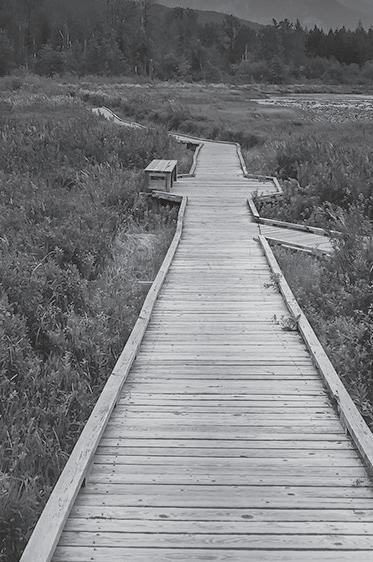
Financial Services Specialist – Temporary Full-Time
NCFDC is seeking On-Call: Infant Toddler, Special Needs, Early Childhood Educator, and ECE-Assistant Licensed individuals, we invite you to submit your application. The Early Childhood Educators work as team members with other child care setting staff and with all the children and families providing general support to the whole program to ensure effective inclusion of the children. The successful candidate will have demonstrated ability in:
• Ability to develop and maintain a warm, caring, responsive relationship with the child.
• Ability to establish and maintain supportive, collaborative relationships with families and staff.
• Ability to maintain confidentiality, positive, professional, nonjudgmental attitude
• Physically ability to carry out the duties of the position.
• Planning and implementing developmentally appropriate curriculum that supports community, inclusion and is culturally significant for young Aboriginal children.
• Understanding and working knowledge of Child Care Licensing regulations.
• Interpersonal, written, oral communication skills and maintaining positive communication with parents.
• Collaborating with community service providers, Self-directed and able to initiate and complete projects.
In addition, the Early Childhood Educators will have:
• A minimum of 2 years work experience in a child care setting.
• Valid Early Childhood Educator Certificate, ECE Licence to Practice or going to school to take Early Childhood Educator courses.
• Clear Criminal Records Check & Current First Aid.
• Food Safe or willingness to obtain.
• Some knowledge of curriculum and philosophies in First Nations Early Childhood settings.

Terms of Employment:
• Monday to Thursday - 8:30am - 4:30pm.
• Start Date: As soon as possible.
• Wage: (negotiable depending on experience).
Cover Letter & Resume to:
Title: Anita Patrick, Director
Agency: N’Quatqua Child and Family Development Centre
The Sea to Sky corridor’s top civil construction company.
We are currently recruiting professionally minded people to join our team:
Equipment Operators
Pipe Layers
Construction Labourers
*Competitive wages, extended health benefits (after 3 months)
Email resume to: info@whistlerexcavations.com
Email: anita.patrick@nquatqua.ca
Phone Number: 604-452-3584
Fax: 604-452-3280
Deadline: until position is filled
We thank all those who apply. Only those candidates selected for interview will be contacted.


Full or Part Time
E-mail or drop in your resume to: rory_eunson@nestersmarket.com please cc bruce_stewart@nestersmarket.com or call us at 604-932-3545
PERKS
• Competitive wage – Depending on experience
• Flexible and set schedule
• Relative training



Full Time, Year Round
Love a good challenge? Passionate about working and playing (golf) in the best place on earth? The Sales & Marketing Manager at the Whistler Golf Club is responsible for attaining revenue targets for all aspects of the golf operation (with a focus on pre-sold group events), and for the effective marketing, reporting and communications required to continue to support and build the business. This position requires an experienced and personable sales approach and a commitment to customer service, with an understanding of marketing strategies to foster a strong brand, and continued revenue growth for the Whistler Golf Club. What we offer: a fun team and work environment, competitive compensation and benefits package, and free golf at our legendary course! TO VIEW OUR CAREER OPPORTUNITIES, AND TO APPLY, VISIT US ONLINE AT WHISTLERGOLF.COM/CAREERS.


Full-Time, Permanent (CUPE 2010)
This role supports the operation of our water distribution, construction and maintenance of park spaces, road and drainage maintenance, trail maintenance, snowclearing and capital project development.



Candidates will be looking for a job that has a lot of variety, confidence operating heavy duty vehicles and an interest to learn more about our water and wastewater treatment operations.

This position is part of the Collective Agreement between the Village of Pemberton and Canadian Union of Public Employees, Local 2010.

Interested? Send your resume to recruiting@pemberton.ca. For a full job description or to learn more, visit Pemberton.ca/employment.

• BUSSERS (evenings) $19/hr
• PREP COOKS (PT) $ 22-25/hr for experience
• HOSTS (evenings) $19/hr
• LINE COOKS FOR $20-23 for experience We've Got You Covered
Love a good challenge? Passionate about the place you call home? Tourism Whistler is looking for community-loving, mountainappreciating, environment-respecting people to join our team.
Come collaborate with us. We’re hiring for the following opportunities:
• Summer Visitor Surveyors (Part Time, Summer Contract)
• Coordinator, Assessments (Part Time, Year Round)
• Maintenance Technician/Cleaner (Full Time, Year Round)
• Visitor Centre Agent (Full Time, Summer Contract)
• Coordinator, Ask Whistler (Full Time, Year Round)
What we offer: a flexible schedule offering work-life balance, a commitment to health and wellness, excellent compensation and benefits package, and a great team environment.


TO VIEW OUR CAREER OPPORTUNITIES, AND TO APPLY, VISIT US ONLINE AT WHISTLER.COM/CAREERS.































“Liar, liar, pants on fire...”
William Blake
ODDLY ENOUGH, the 1810 Blake poem, The Liar, didn’t contain that exact line. Yet, it continues to be cited as the source.
It did, however contain the verse:
“What infernal serpent
Has lent you his forked tongue?
From what pit of foul deceit
Are all these whoppers sprung?”
BY G.D. MAXWELLAnd for the purposes of what is to follow, I say, close enough. Yes, friends, we are veritably surrounded by tellers of whoppers, serpents with forked tongues, people who fabricate with no conscience and bring to mind the old joke, “How do you know when (fill in your personal favourite here, I believe when I heard it the target was the head of personnel) is lying to you? Their lips are moving.”
That said, in these times and with multiple modes of impersonal communication, no lips need move. Fingers text, tweet, email, and the culprits hide behind a cloak of anonymity.
This has all bubbled up most recently from several sources. And, frankly, it’s a tossup between which source is most reviled in town. So I’ll just flip a coin and, son of a gun, Vail pops up first.
In response to Paul O’Mara’s letter in last week’s Pique, “Serious injury on Whistler Mountain ‘could have been avoided,’” an unnamed “representative” for Whistler Blackcomb stated, “We also place the utmost value on safety, as it has always been—and remains—our top priority.” Italics mine.

Liar, liar, pants on fire.
Perhaps I’m being too quick to judge. Perhaps whomever penned that whopper was just ignorant and not deceitful. Perhaps it was written by a Broomfieldian who has never, in fact, set foot, ski or board on Whistler or Blackcomb. In that case, feel free to wear the sobriquet ignorant rather than liar for whatever moral comfort it may provide.
But for those of us who frequently slide down either Whistler or Blackcomb, we can only wonder in what universe the respondent resides. Anyone who frequents the mountains would more likely guess safety is unlikely to be any priority or, perhaps if it is at all, it is likely not among the top 20 priorities for the carpetbaggers running the show these days.
Dear unnamed respondent: The top priority of Whistler Blackcomb— Vail Resorts—is profit. Full stop. Profit, maximizing shareholder return, however you want to say it, has pride of place in the firmament of the corporation. It outshines all other priorities, informs all operations, drives all decisions, leaves no room for other trivial
matters like guest safety.
How has WB become less safe since passing into the hands of Vail? Let me count just some of the ways.
The former Safety Department, that small army of volunteers who used to stand safely on the downhill side of the yellow “Slow” signs scattered around the mountains at choke points and family zones have been replaced by, well, “Slow” signs. Like most signs, they are ignored. To be fair, they were often ignored when manned, but the yellow jackets frequently chased down the
share tidbits of data like how many injuries Ski Patrol attended to per 1,000 visitors. No reason not to, since the number was generally better than what was considered a good target. Last time I asked, it was around 1.7 per 1,000. Try getting that information these days and someone in Broomfield will have a stroke.
If safety was any priority, more resources would be steered toward grooming. In the era of the Coefficient of Epic and repeated increases in uphill capacity—bigger lifts— grooming is a key lever in safety. It is unsafe to get more people up the mountain faster if

locals, yes, Peak to Creek, is a serious safety trap. What used to be groomed twice a week is now groomed closer to twice a season. Wellfounded gossip last year was that at least some members of Ski Patrol threatened to stop rescuing people on the run until the moguls were groomed out, because taking a toboggan down was simply unsafe.
Top priority? Sayin’ it don’t make it so.
But don’t feel bad. You’re in good company. Closer to home, the Resort Municipality of Whistler’s touted strategic priority, community engagement, has and still is taking a kicking lately. The shameful, quicker than you can say community engagement approval of the new Fitz lift—needed only for the bike park, since the quad is woefully under-utilized by skiers—in exchange for money and no more parking was an affront to the whole community.
miscreants skiing dangerously, caught them and managed to get their passes hotlisted for a period of time.
In that regard, safety has been reduced to signage and some fencing.
And on the subject of signage, as many people have asked, what happened to the signs reciting what used to be called the Skiers’ Responsibility Code that were tacked up on the first dozen lift towers? Perhaps they’ll be auctioned off like the old Fitz lift chairs. A quaint relic of the past.
It’s easy to argue the mountains are less safe these days. Harder to prove. It didn’t used to be that hard. WB, even before B and even after the two were joined, was willing to
there aren’t sufficient ways for them to safely get back down. And for many, groomed runs equal safety.
As important as providing that terrain is providing safe ski outs at day’s end. Yet, we see fewer groomed ways down than we used to. I barely need to take off both gloves to count the number of times Lower Franz has been groomed this season to provide an alternative to Lower Dave to Creekside. Lower Gearjammer on Blackcomb has seen grooming machines more frequently, but not that often.
And the marquee run on WB, the run that is touted in ski magazines, the one always voted the best run on either mountain by
So far, that strategic priority has only resulted in a new general manager being hired. While I wish Ms. Elliott success, I’m wondering exactly what universe the just-announced plan to severely curtail question-and-answer period at the beginning of each council meeting squares with the idea of enhancing community engagement.
It feels like we’re drifting further and further into that brave new world scheduled to arrive almost 40 years ago. A world where war is peace, freedom is slavery, and ignorance is strength.
Lack of trust, lack of faith, lack of empathy for people in positions of power are what follows from being repeatedly lied to. What follows after that isn’t pretty.
As a former U.S. president was reported to have said, “Don’t be pissin’ down my back and tellin’ me it’s raining.”
Stop lying. ■
The top priority of Whistler Blackcomb—Vail Resorts—is profit. Full stop.
329 - 4314 Main Street: Beautifully updated, bright and spacious one-bedroom condo in the heart of Whistler Village. Selling fully furnished and turn key. The perfect investment property or unlimited owner use. $1,050,000

Maddi MacDonald 604-313-2029
22 - 2250 Nordic Drive: One of a kind 1br/1ba/1-car garage townhome at the base of the ski trail. Large decks, wood burning fireplace, furnished and ready to enjoy as your Whistler escape. Phase 1 zoning allows nightly rentals. GST paid. Open house Sat & Sun, 2-5pm. $1,340,000 Rob Boyd - Boyd Team 604-935-9172

416 - 4557 Blackcomb Way: Possibly THE BEST location of any 1-bedroom nightly rental residence in Whistler, 416 Le Chamois will impress. Unobstructed mountain views from this bright, renovated ski in – ski out apartment located right in front of the Blackcomb Gondola base. $1,379,000

Nick Swinburne PREC*
604-932-8899
6693 Tapley Place: Serenity – A custom-built gem situated on a 2/3 acre of flat lot with a manicured yard. This 5,900 sqft house was well designed and built with the best craftmanship and finest quality materials. A true Whistler dream house.




$12,880,000
Ruby Jiang PREC*
778-834-2002
2 - 2030 Chamonix Cres: Spacious 3.5 Bed/2 Bath townhome in Whistler Creekside within walking distance to Creekside gondola, shopping, Alpha Lake & great local restaurants. Open living plan with lots of storage. No AirBnB. $1,549,000 GST Exempt. Janet Brown 604-935-0700

401(G2) - 4653 Blackcomb Way: Beautiful top floor/corner unit with spacious 2 bed, 2 bath layout. Features; heated outdoor pool, hot tub, games room, gym, ski-in access, free area shuttle & much more. Enjoy one week each month!
$385,000
Kerry Batt PREC*
604-902-5422
73 Garibaldi Drive: 73 Garibaldi Drive is a spacious 3,170 sq/ ft home that is situated on a quiet 7,535 sq/ft lot within the quiet & serene Black Tusk development that is a short 15 minute drive to Whistler! $1,899,000
Maggi Thornhill PREC*
604-905-8199
Paradise Valley, Squamish: Escape to your 9-acre waterfront estate. Living down valley offers the outstanding lot size & the absolute privacy that doesn’t exist in Whistler. 38 minutes to the lifts. Live in the carriage home, build a 5400 sq ft dream home. $3,185,000

Ken Achenbach
604-966-7640
40891 The Crescent, Squamish: Spacious layout and highend finishes, this home has everything you need to live in comfort and style. Spa-like ensuite, and covered balcony with stunning mountain views. Includes large hot-tub and great privacy. $2,695,000
Angie Vazquez PREC*
778-318-5900

